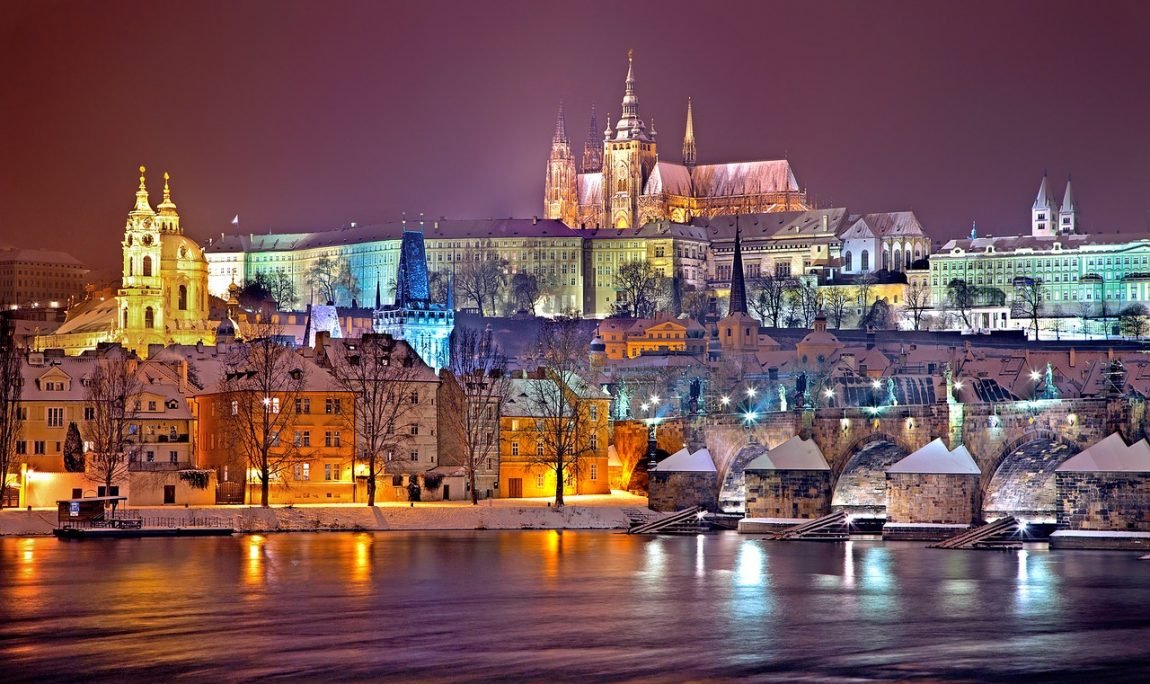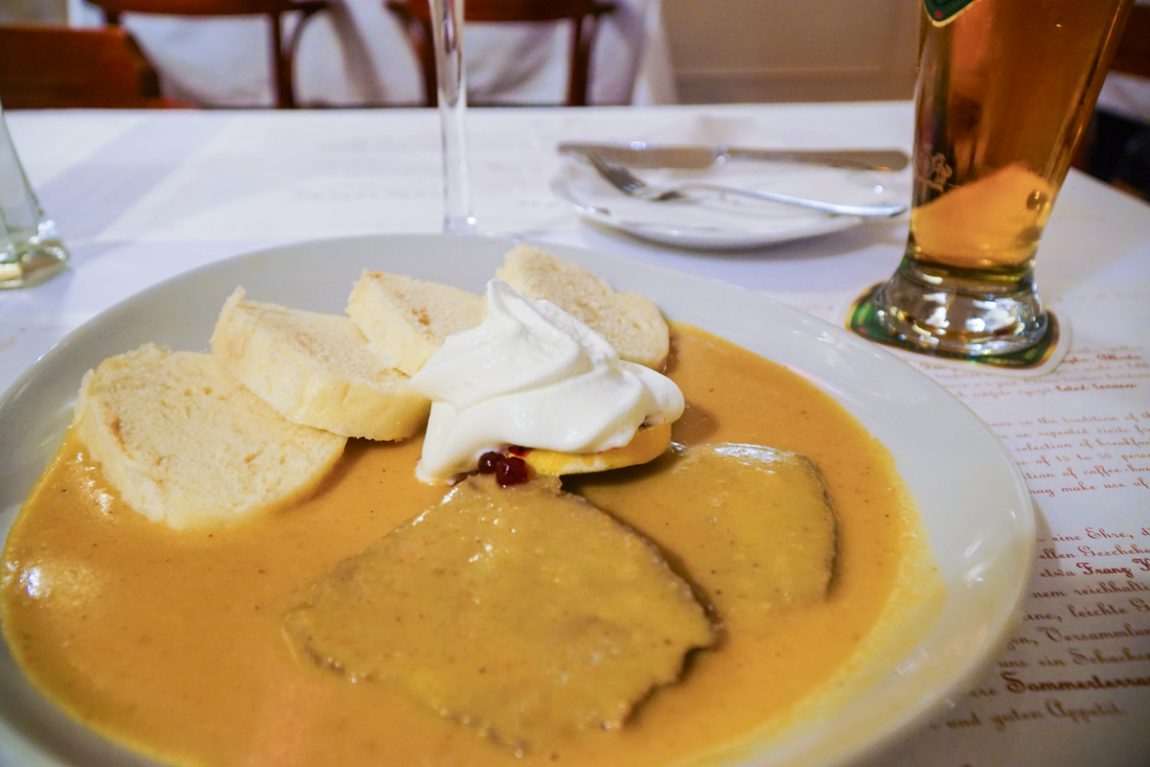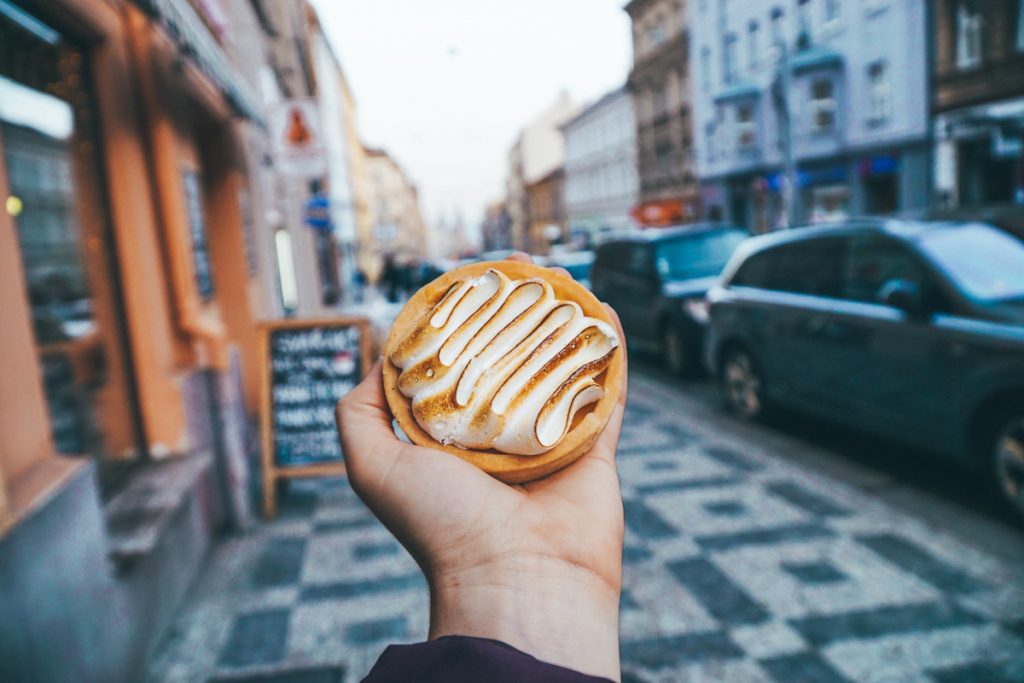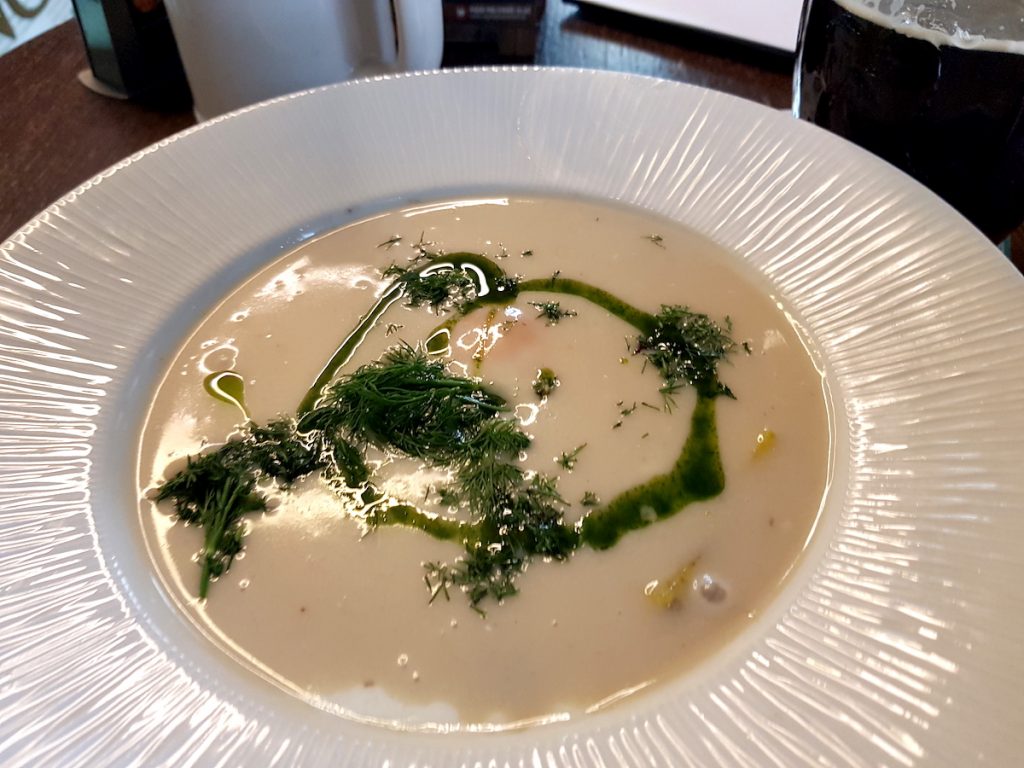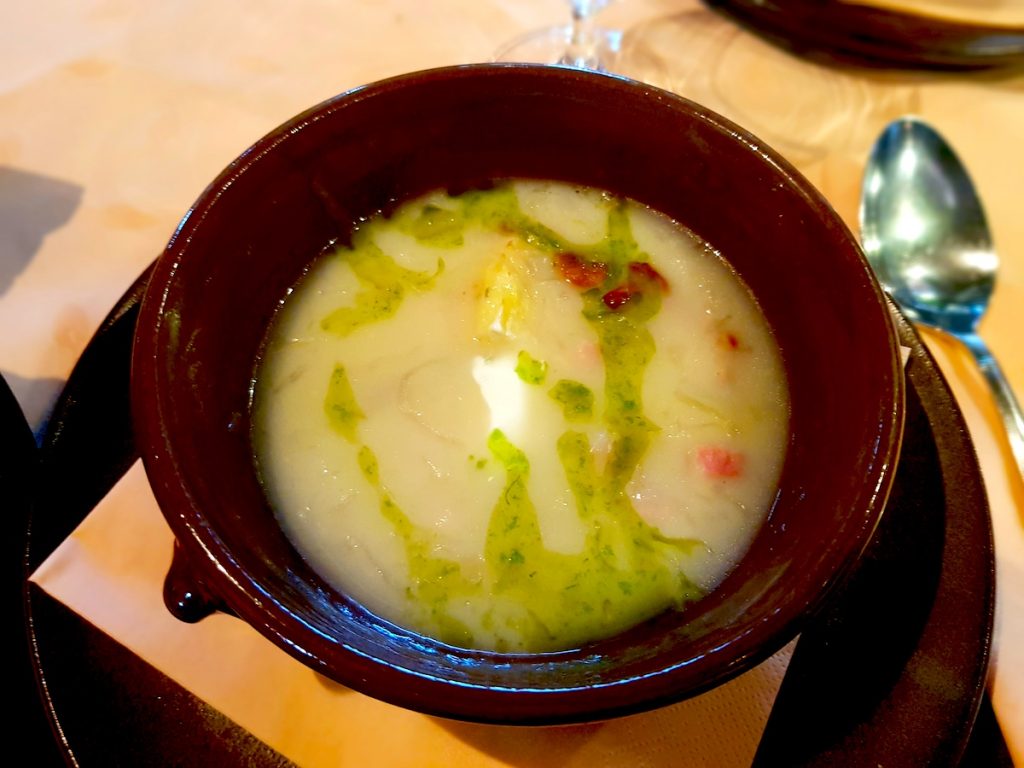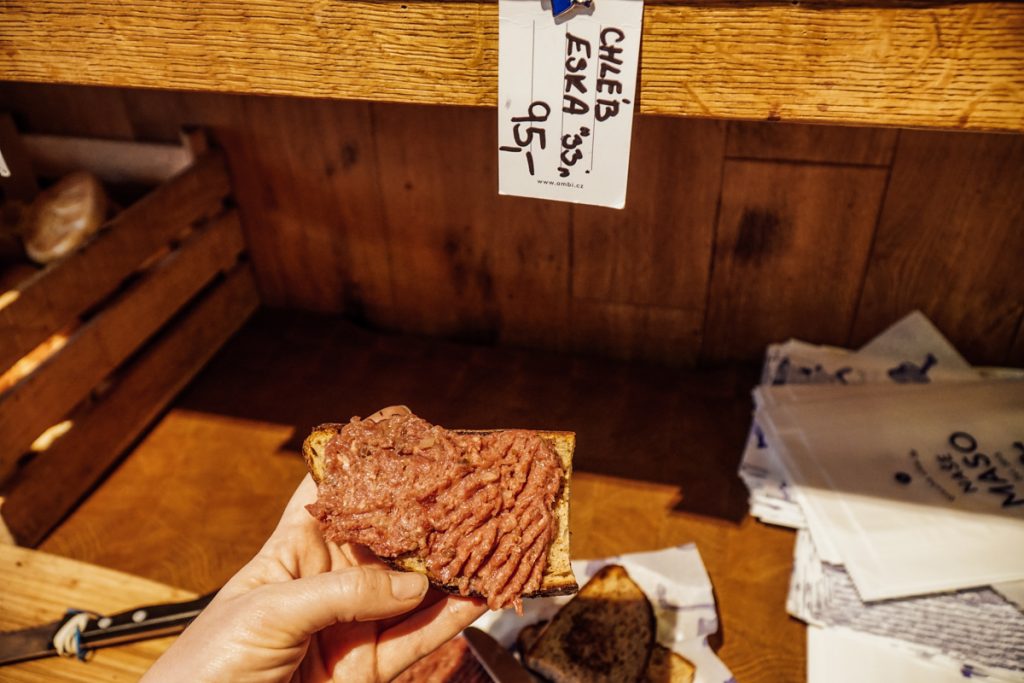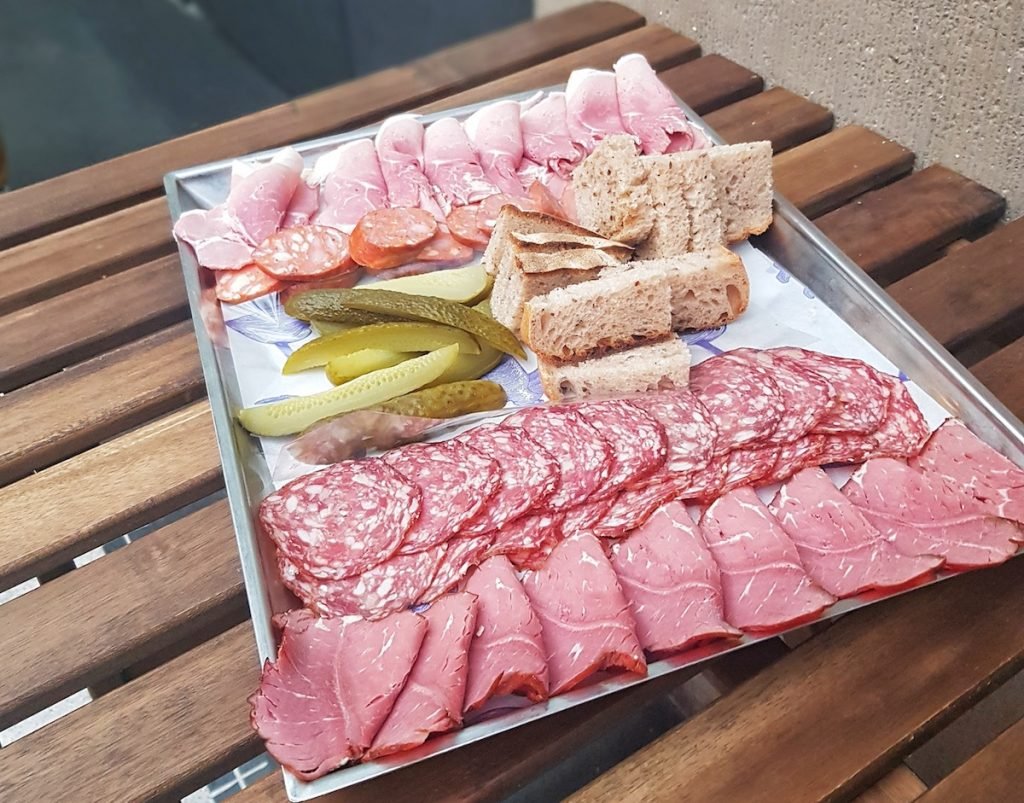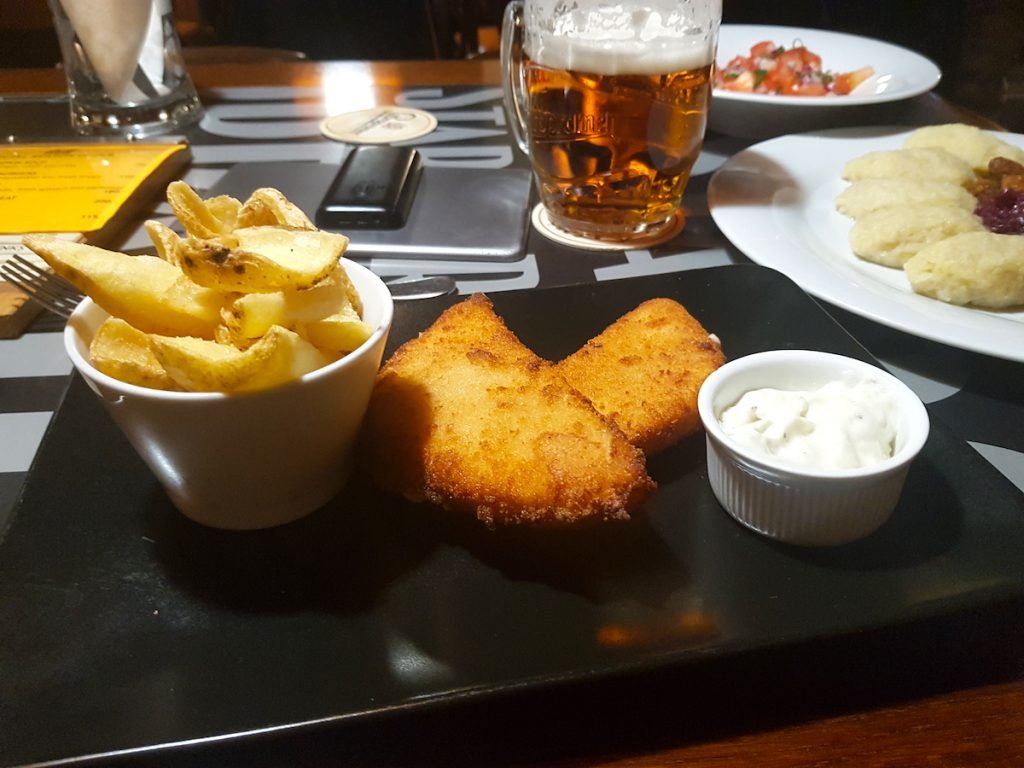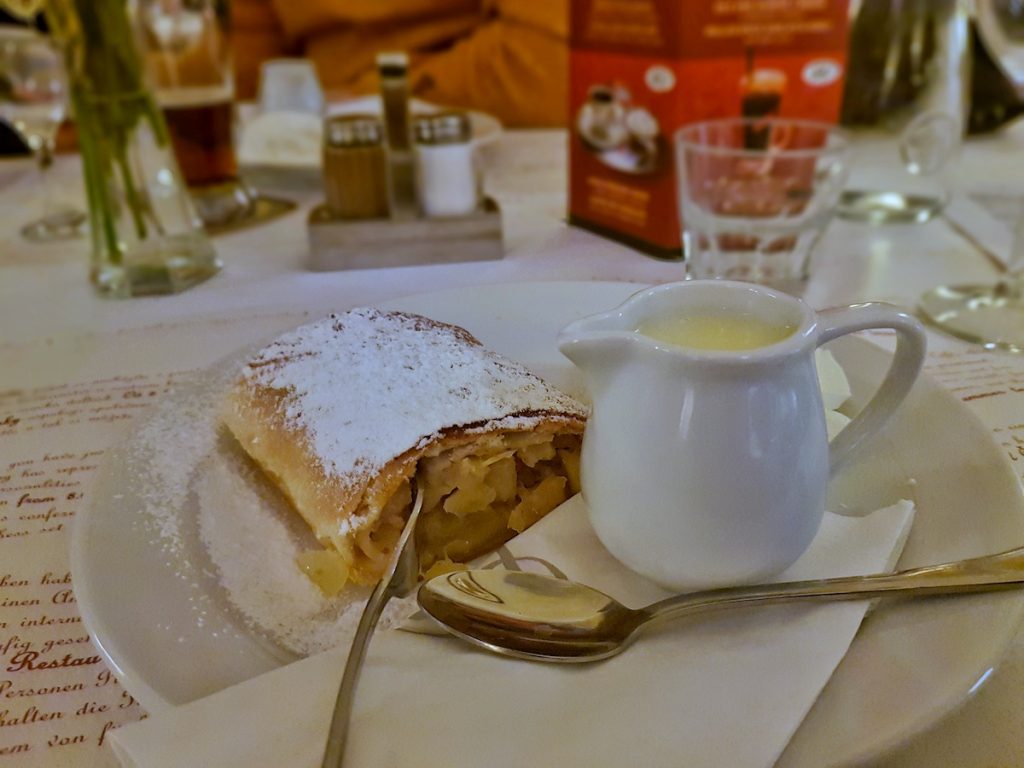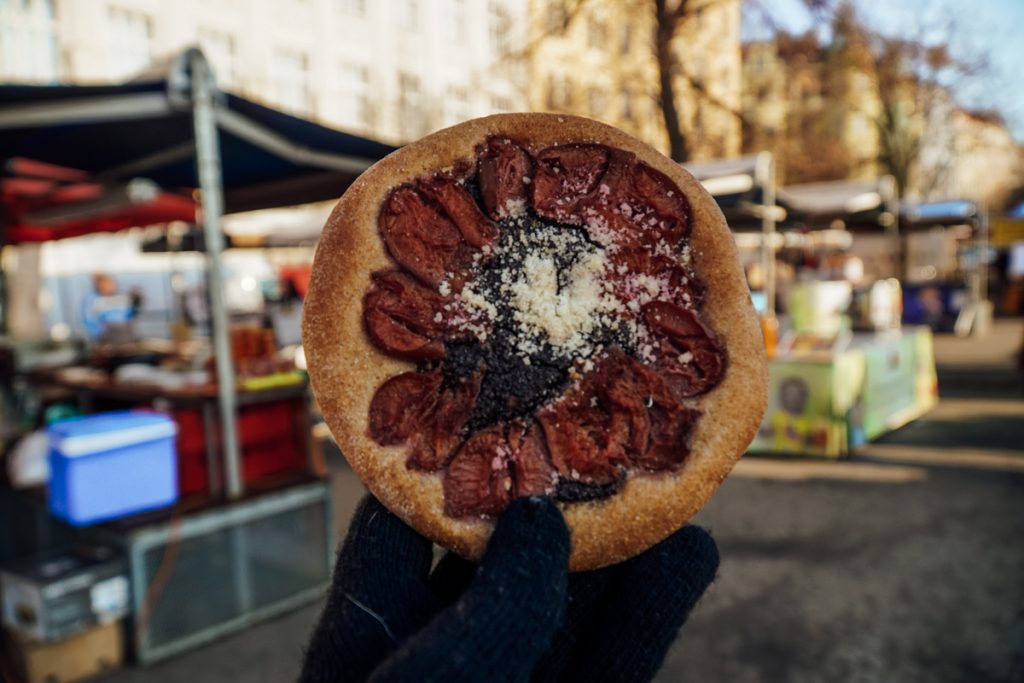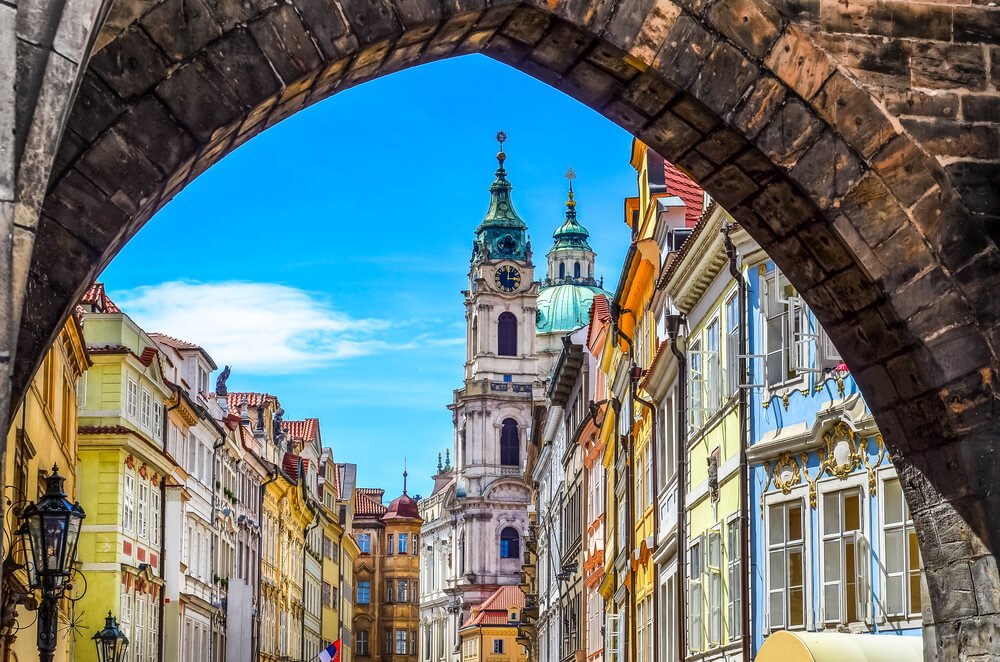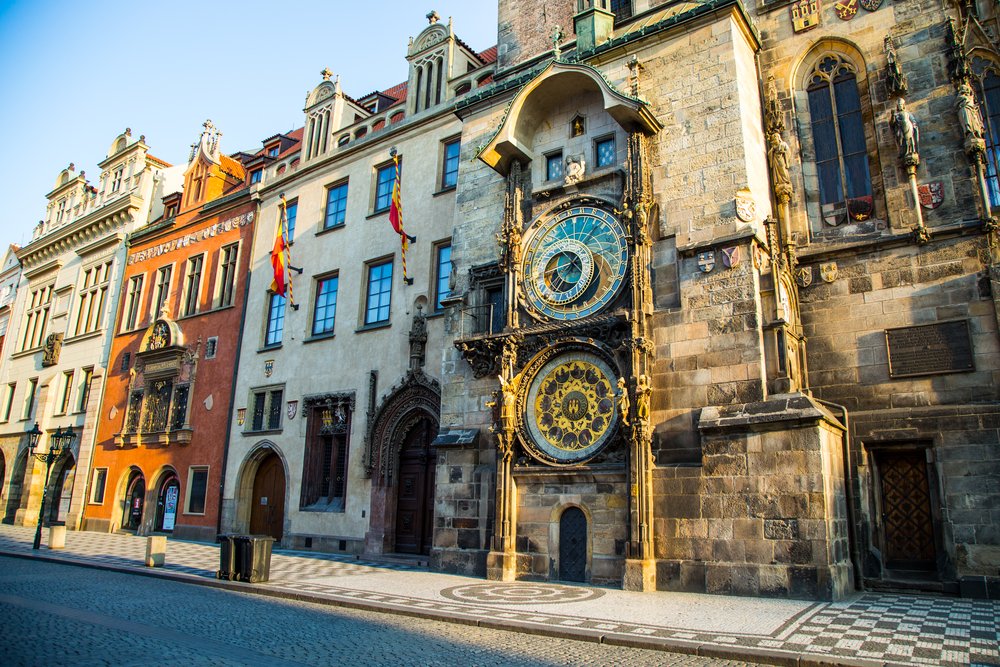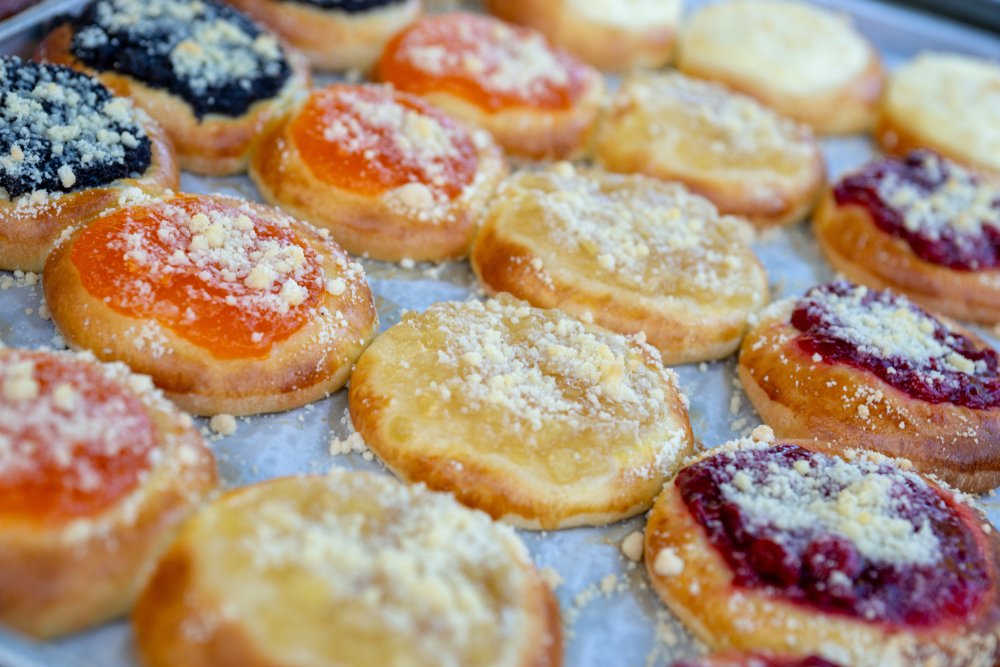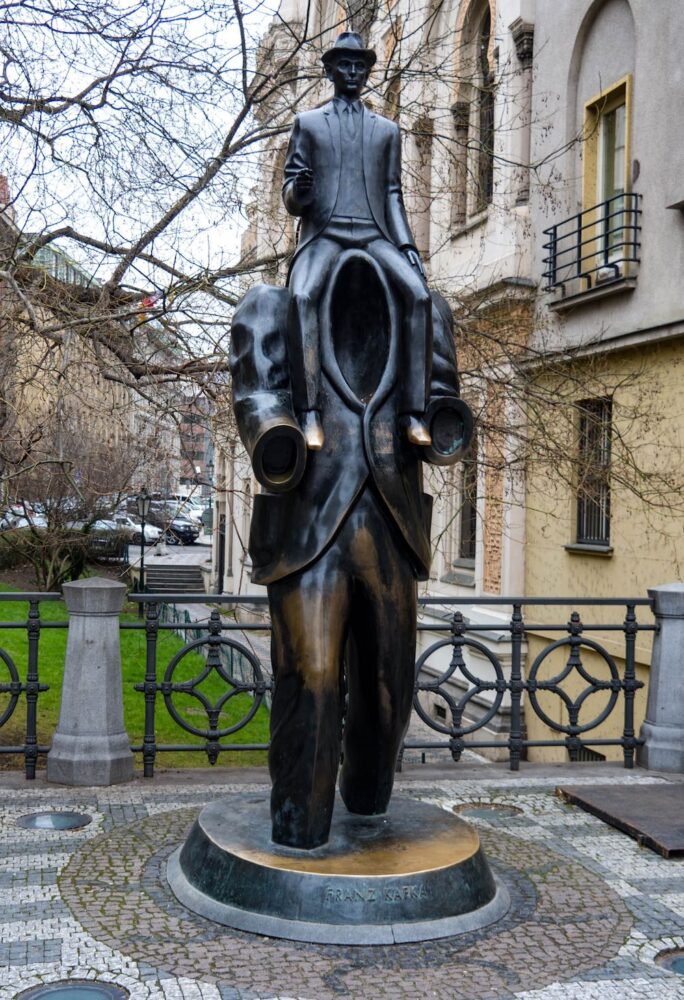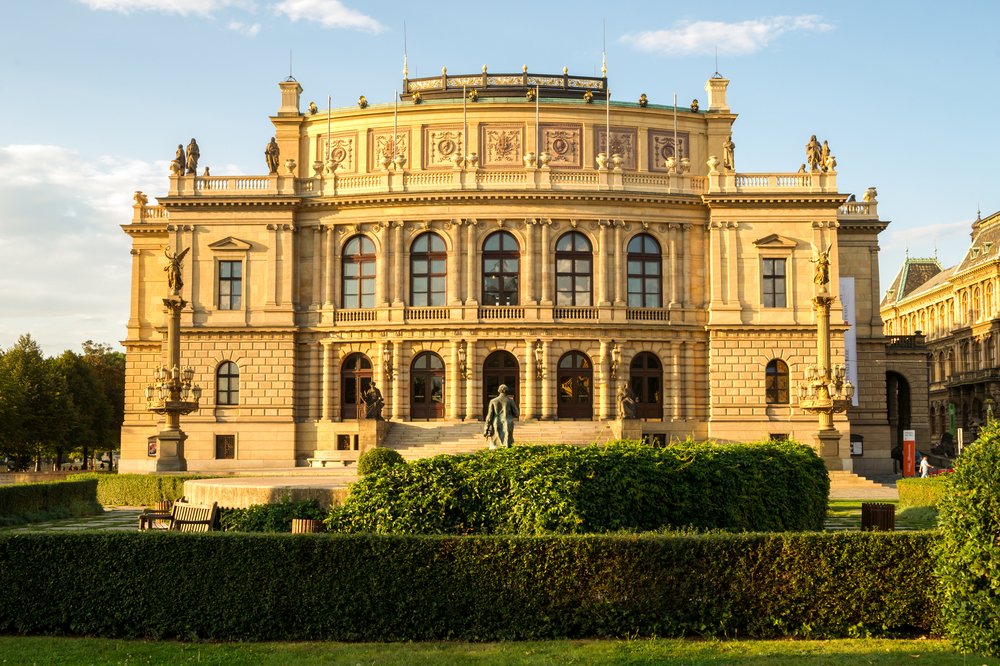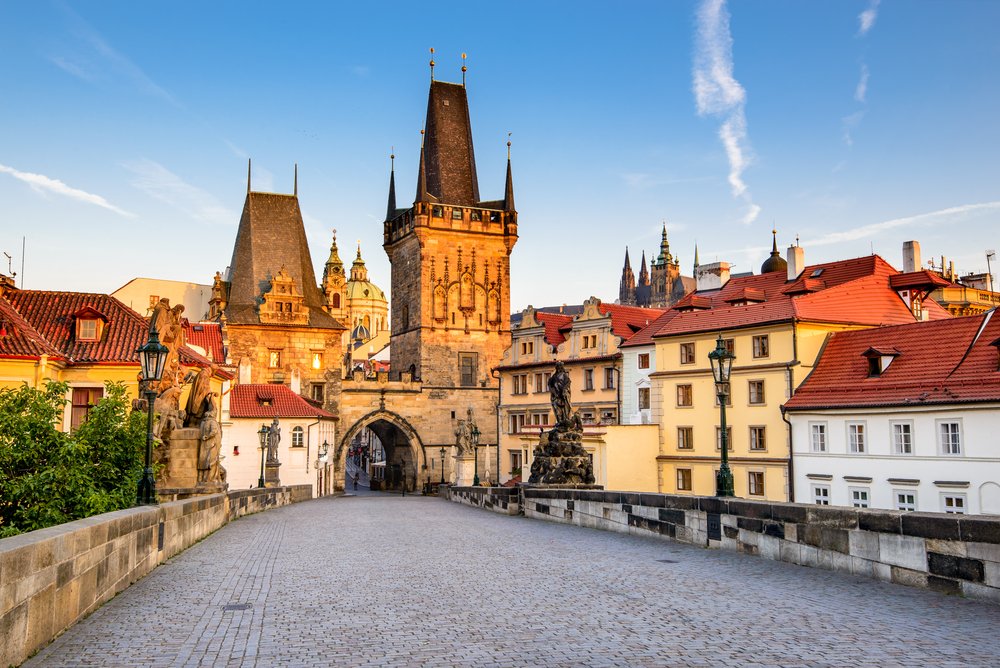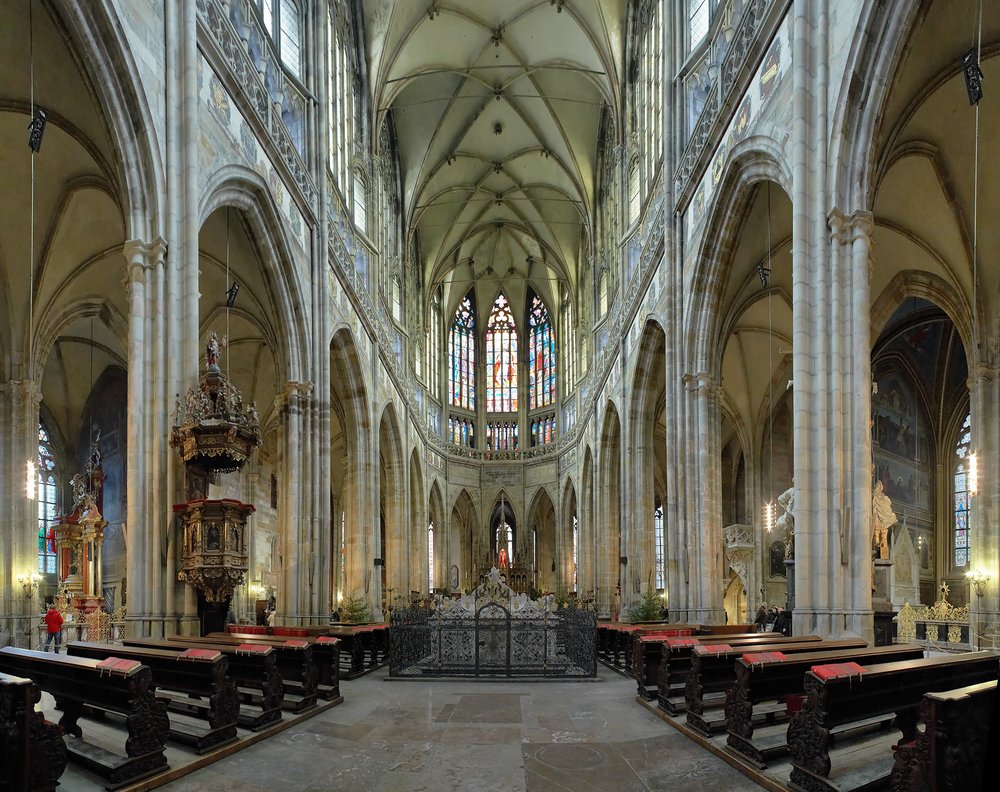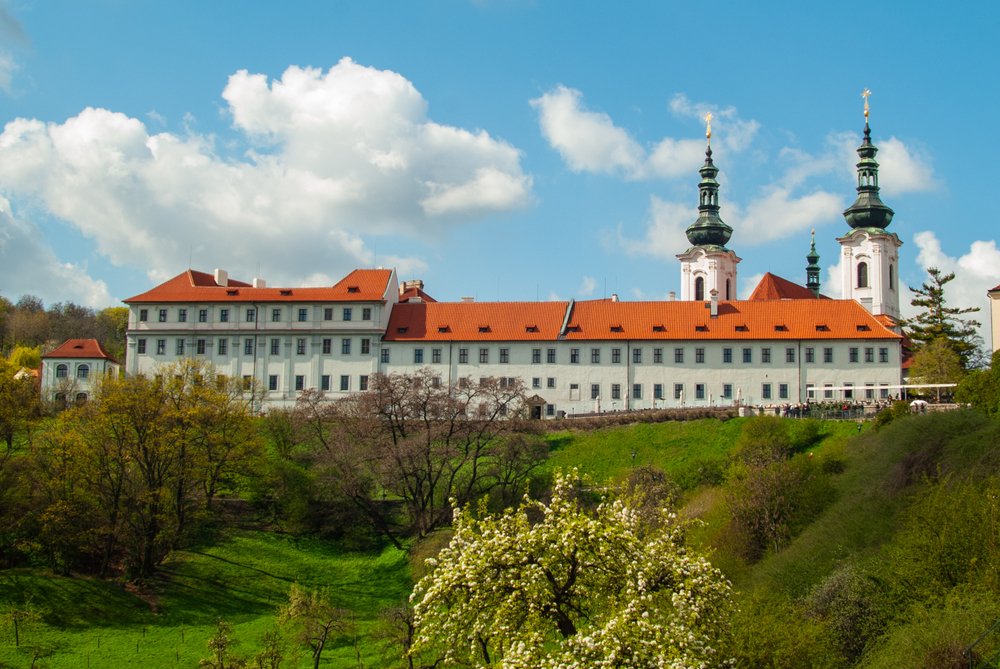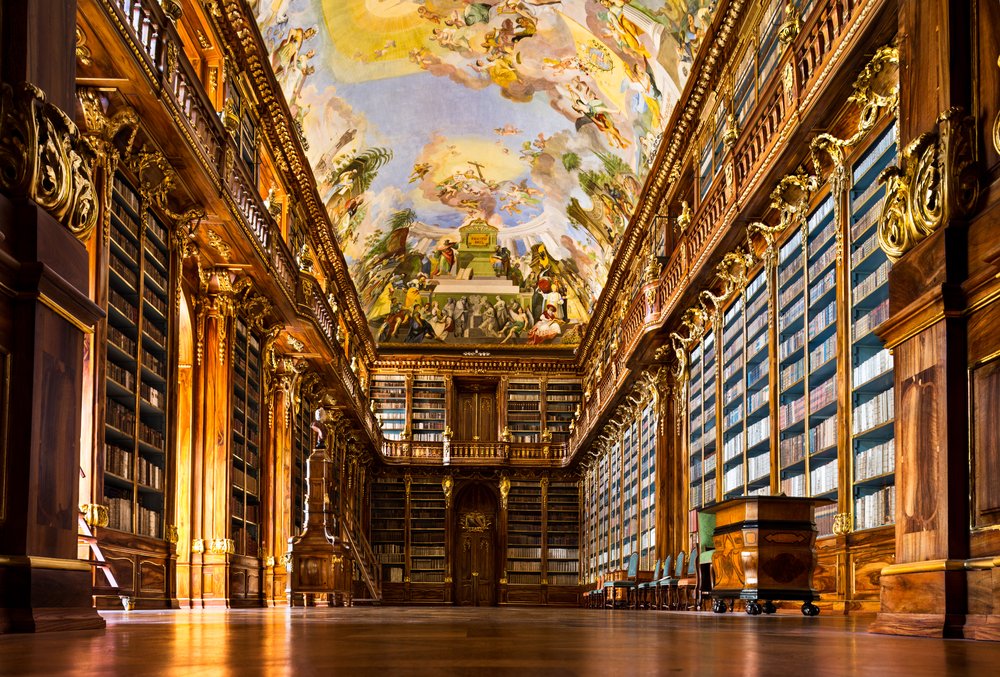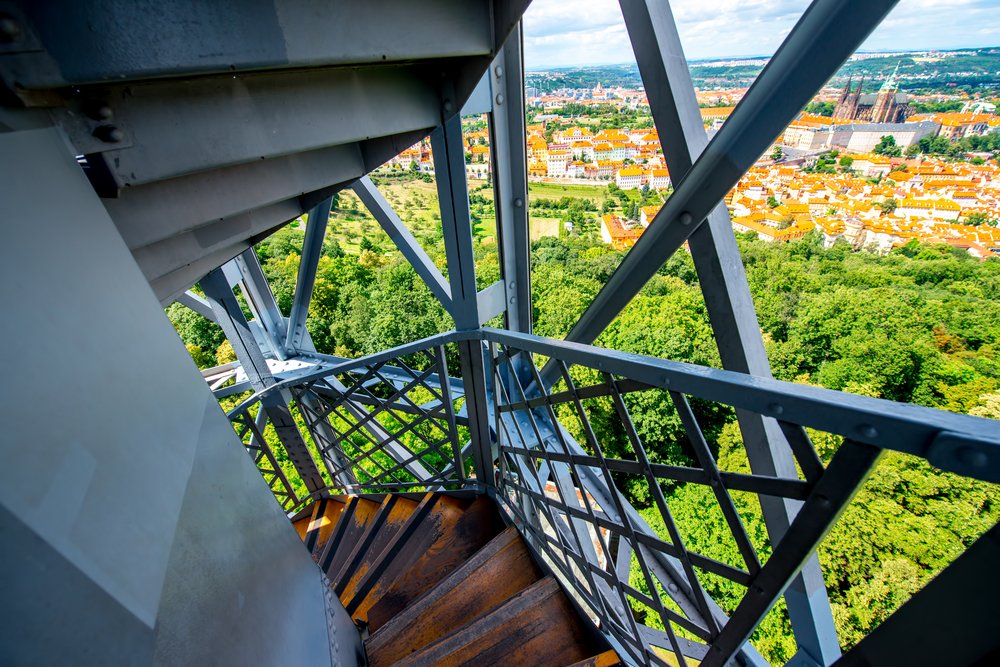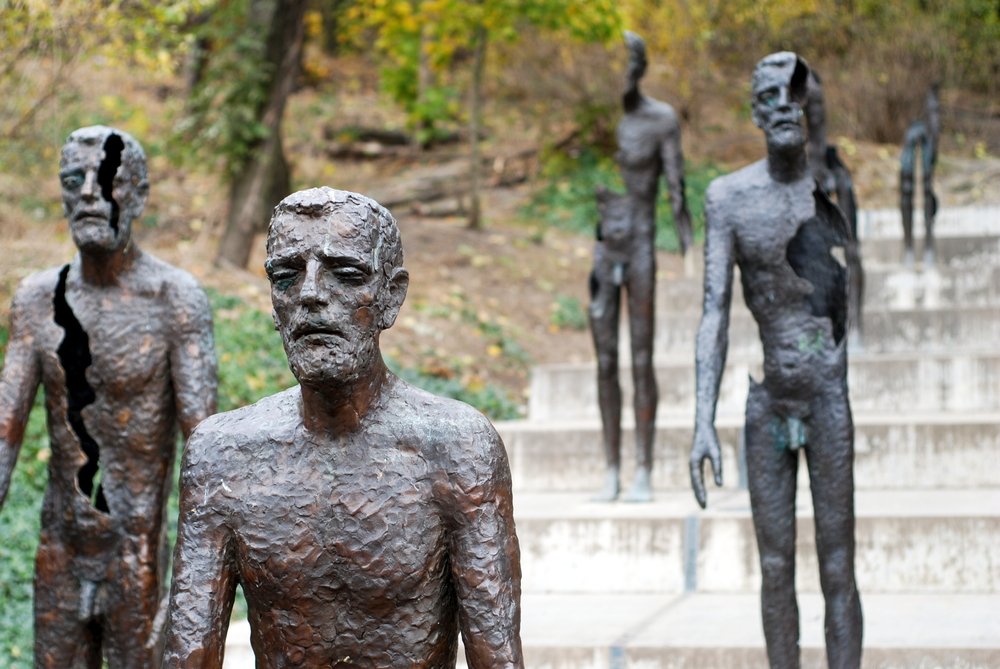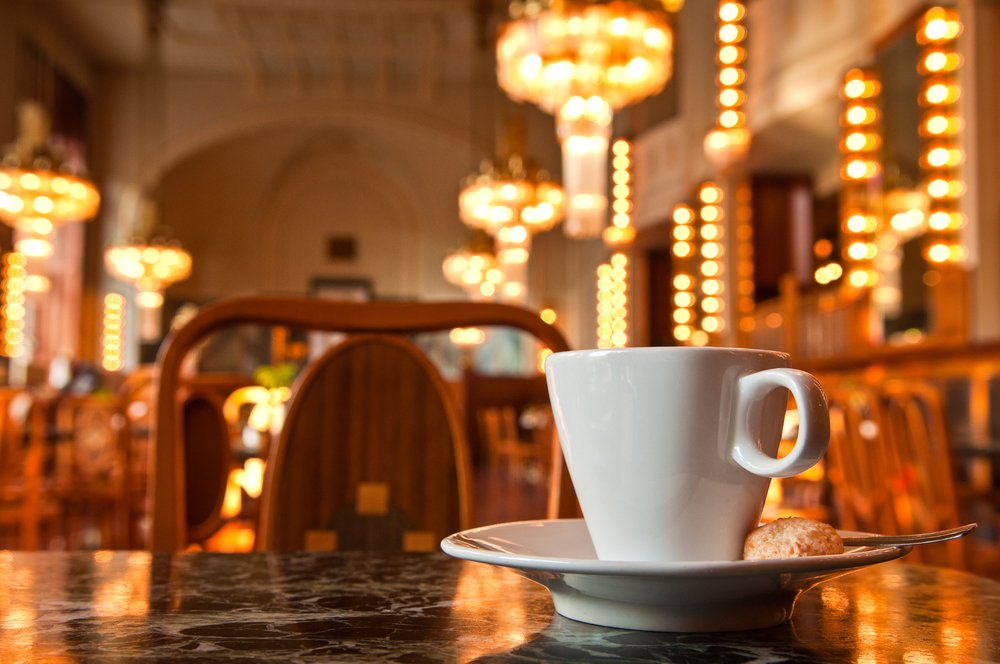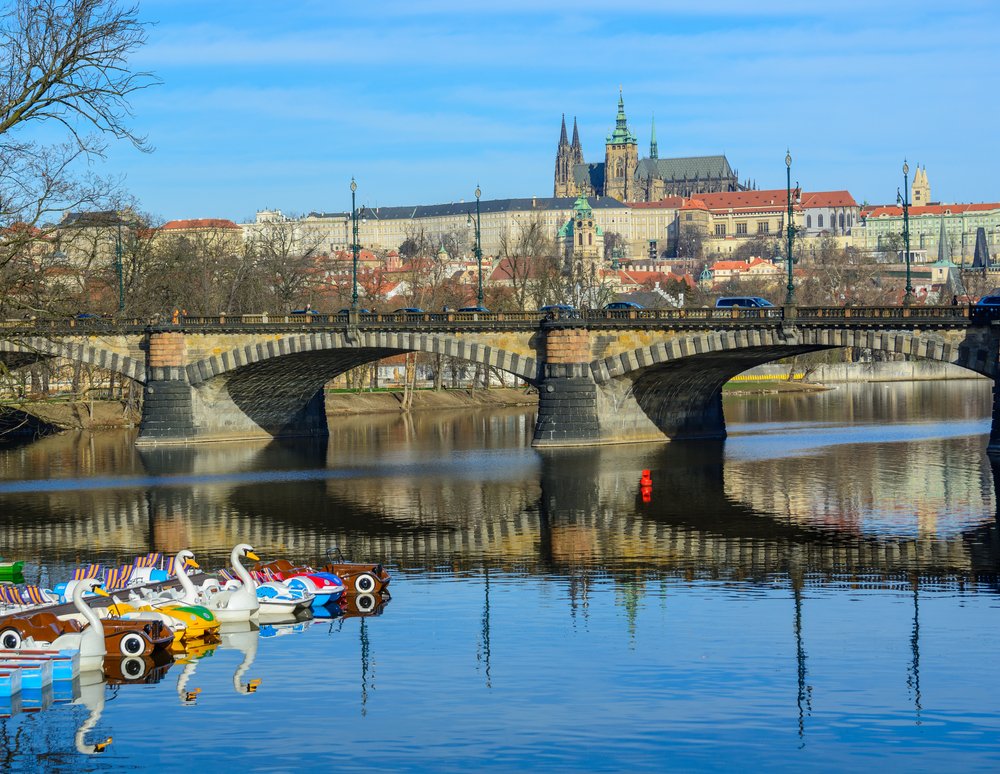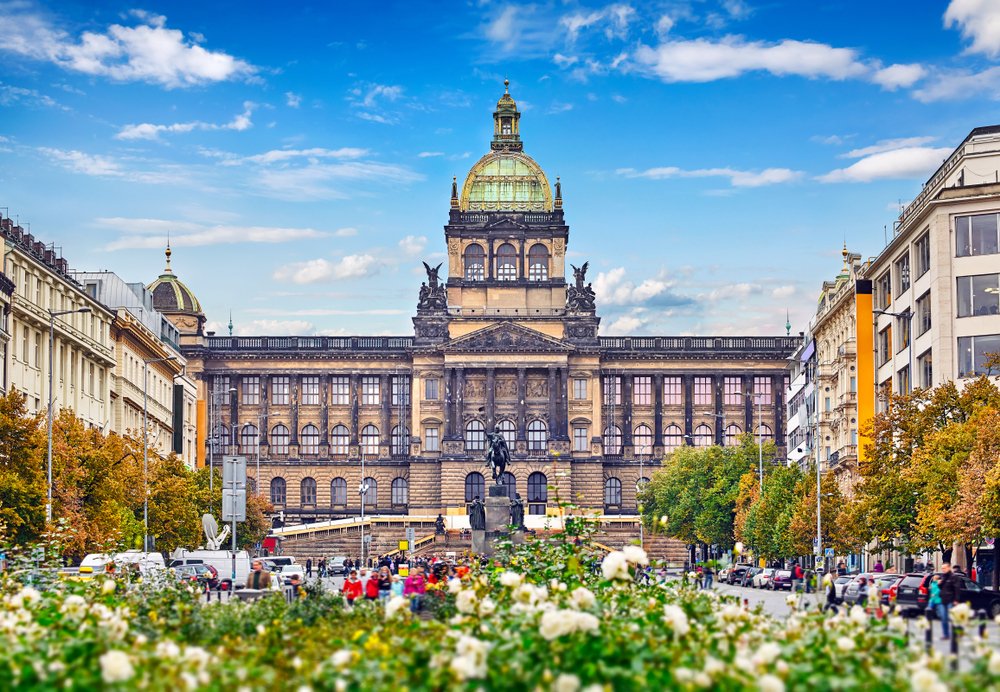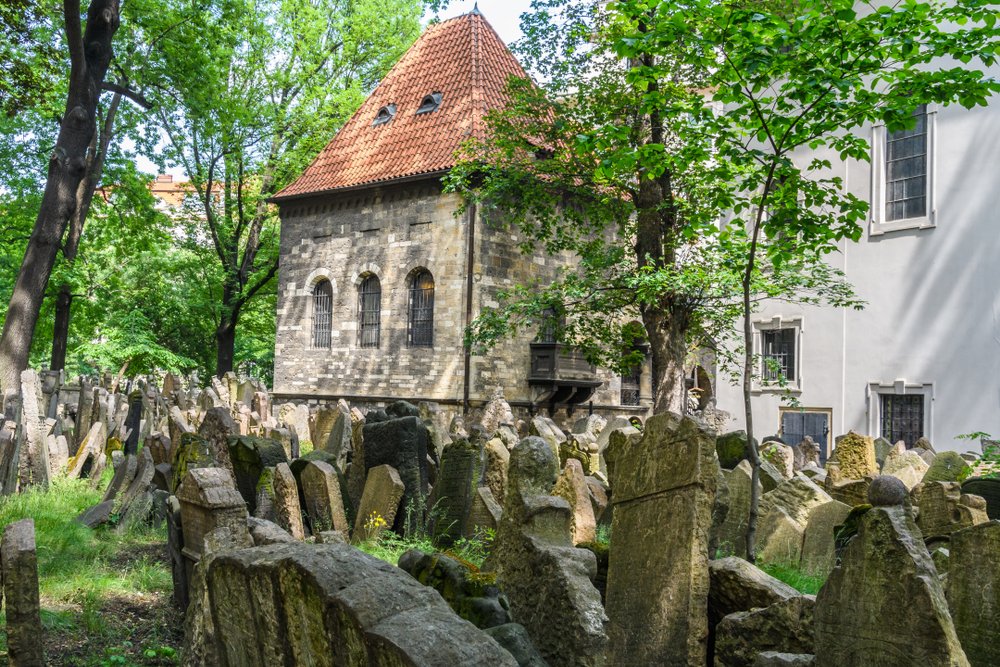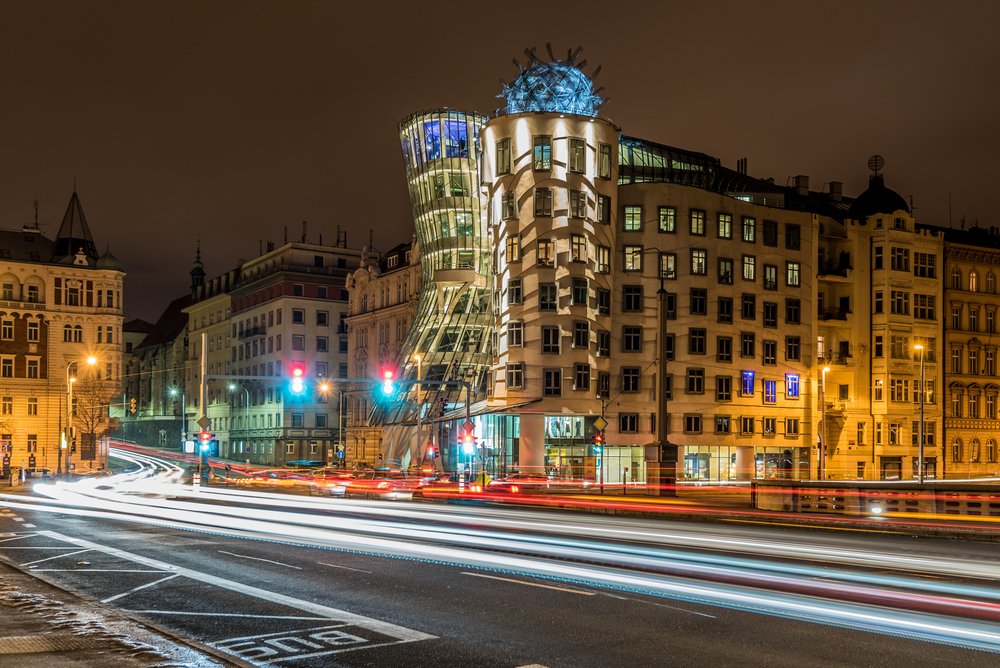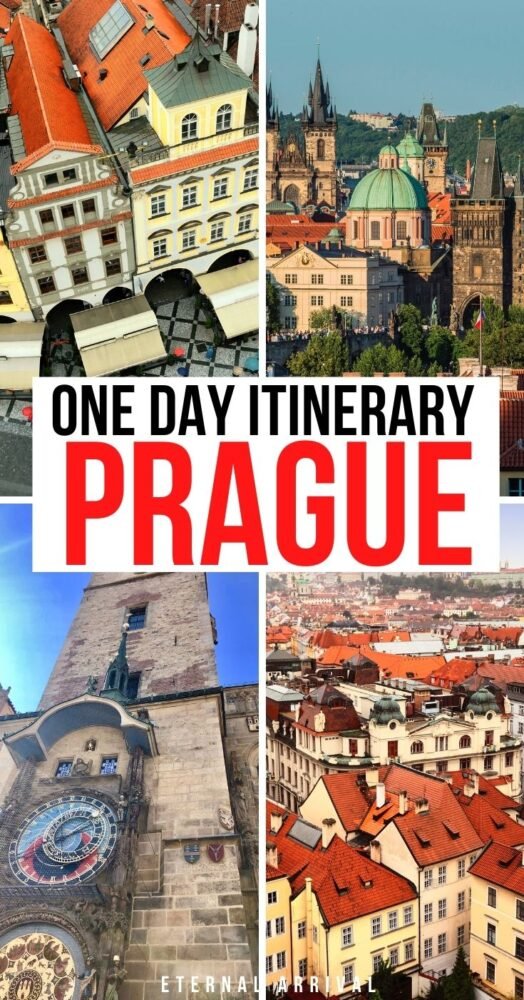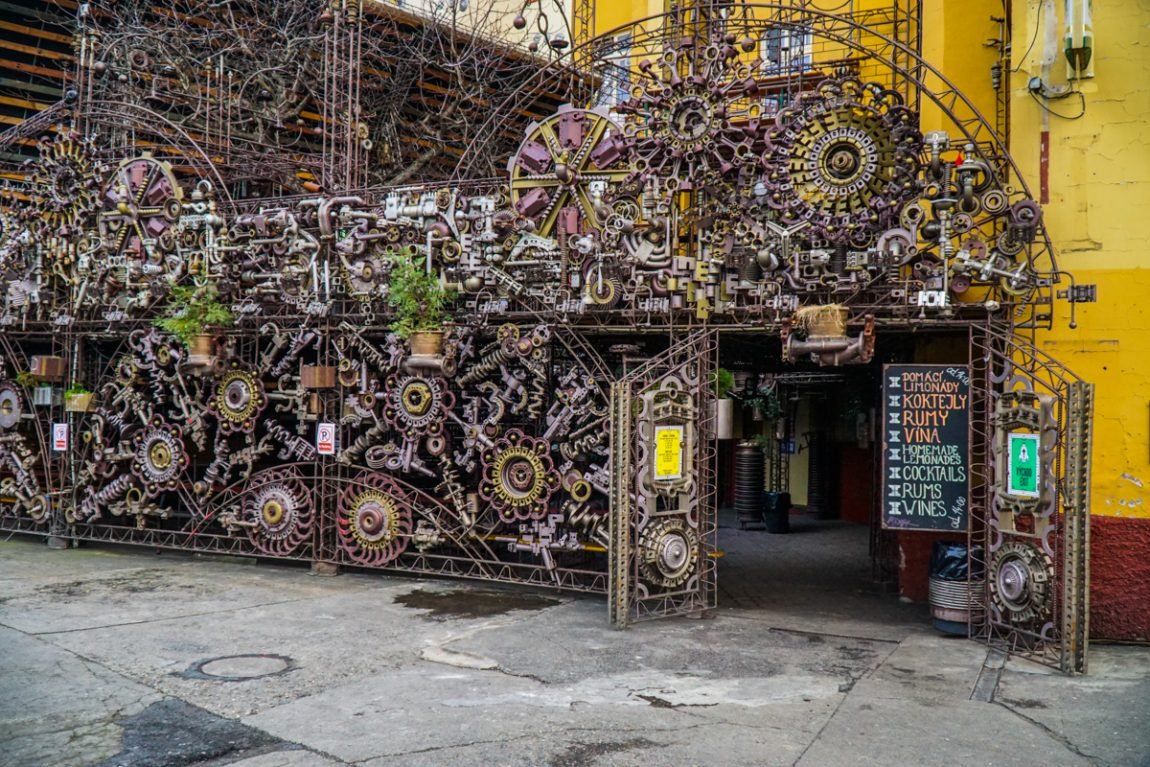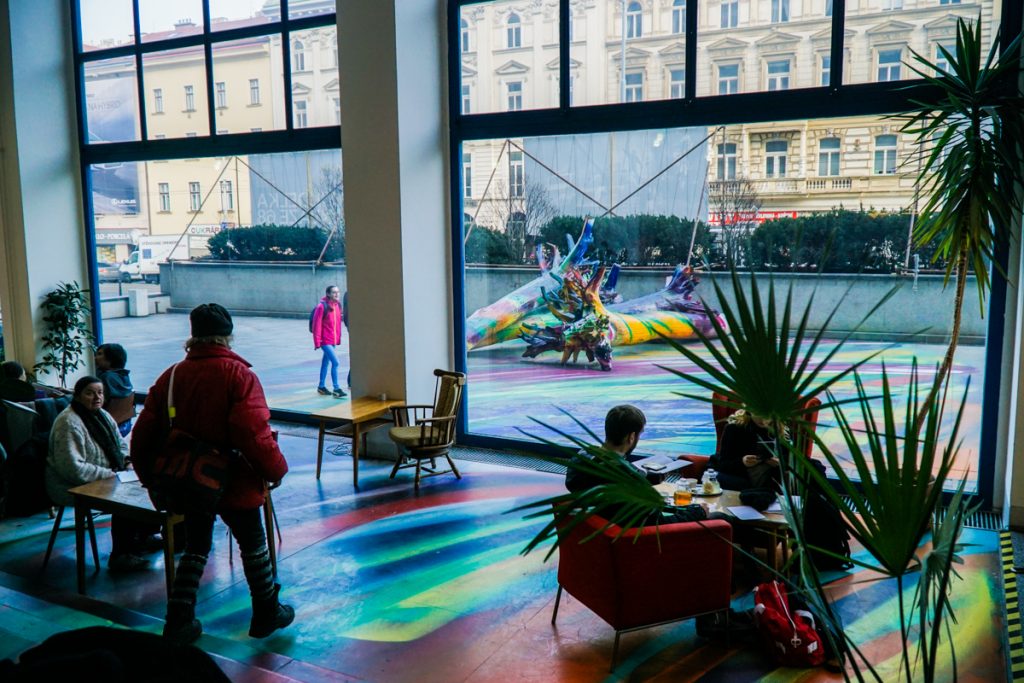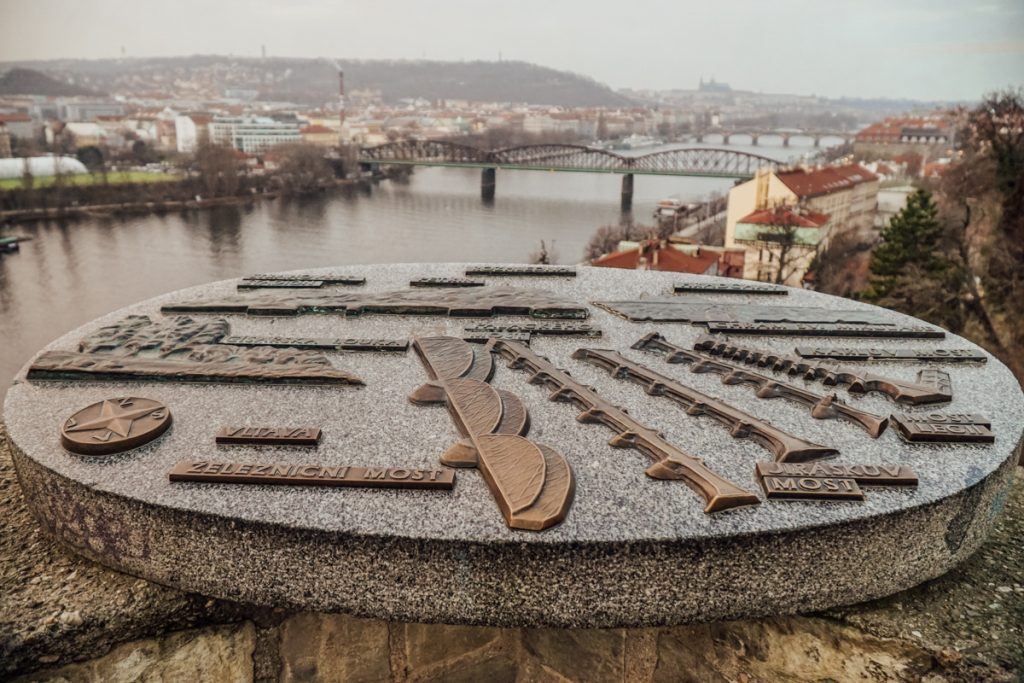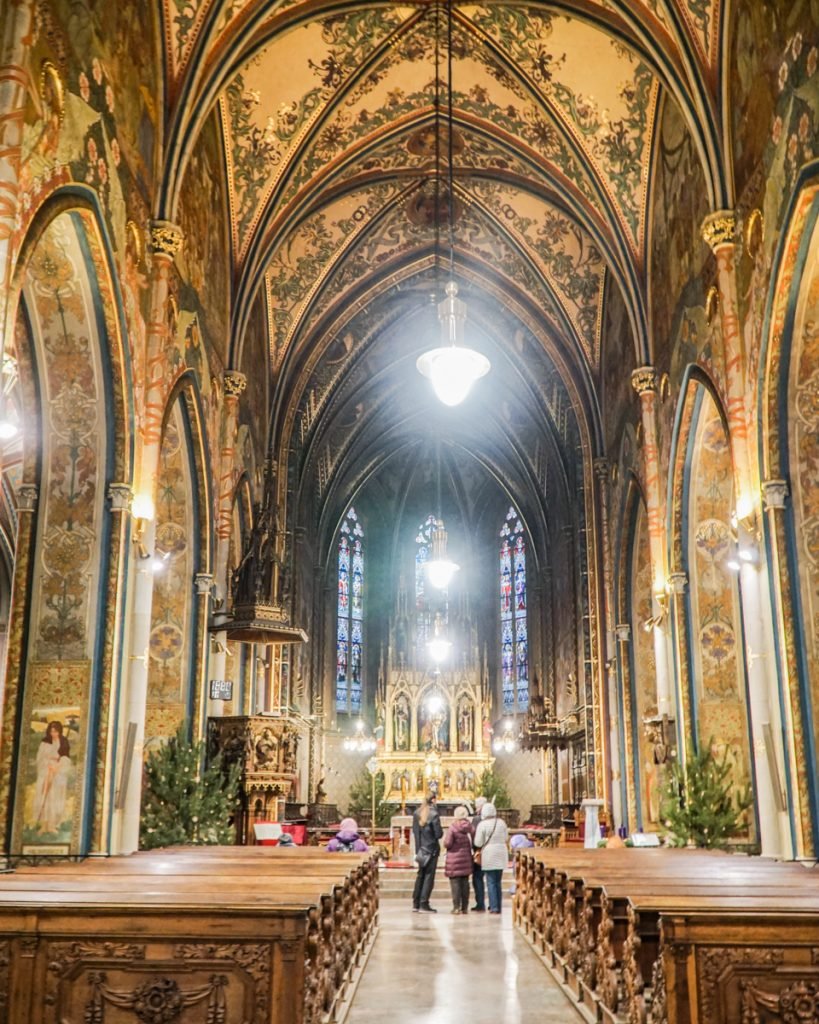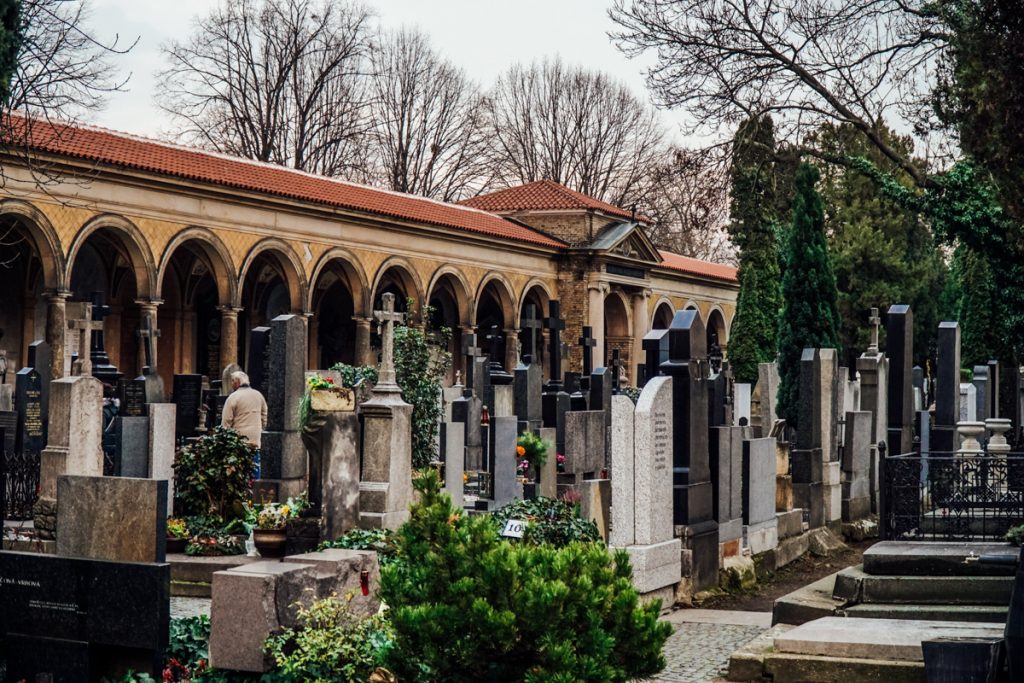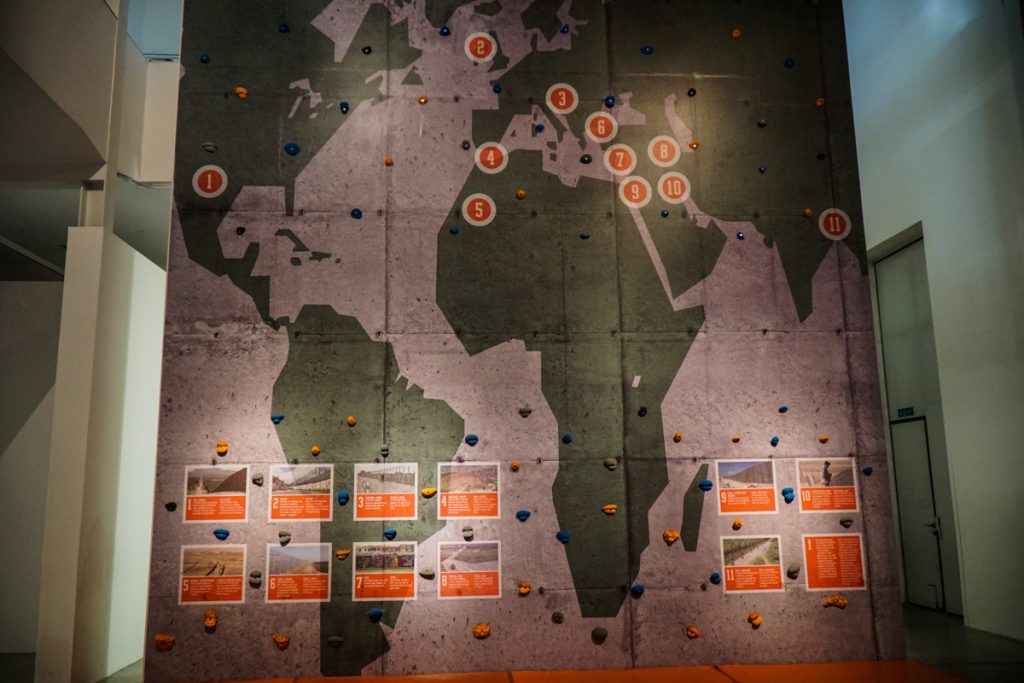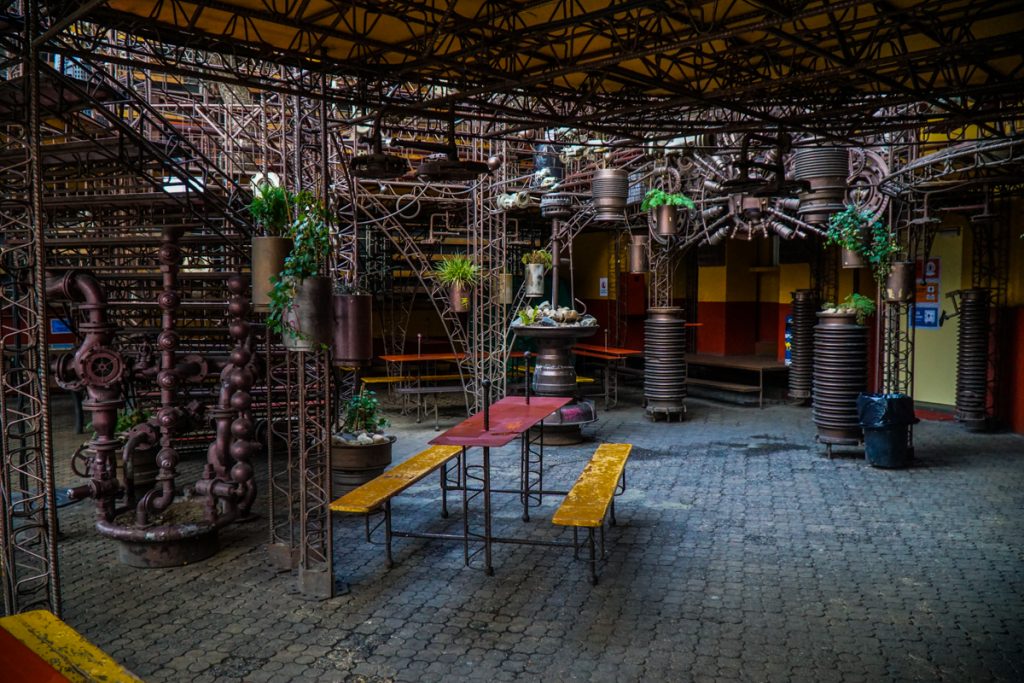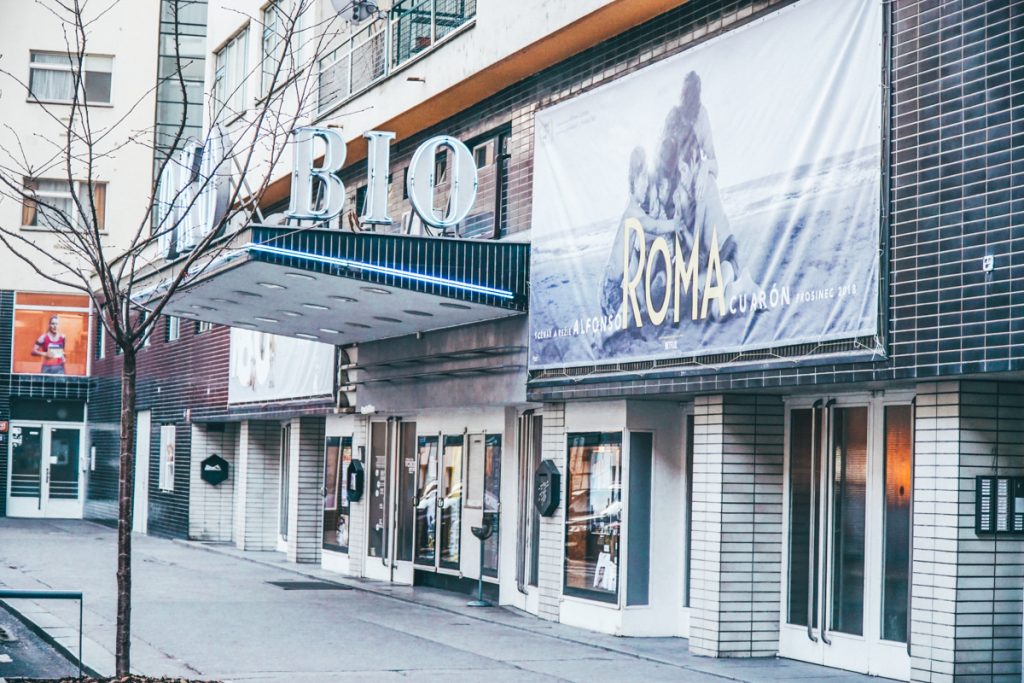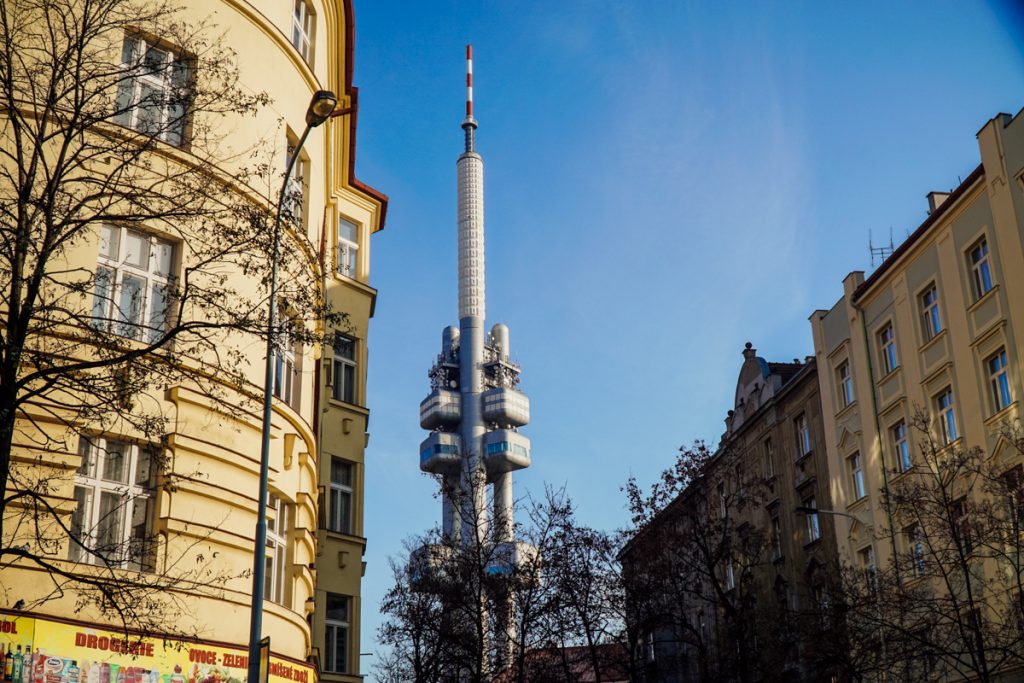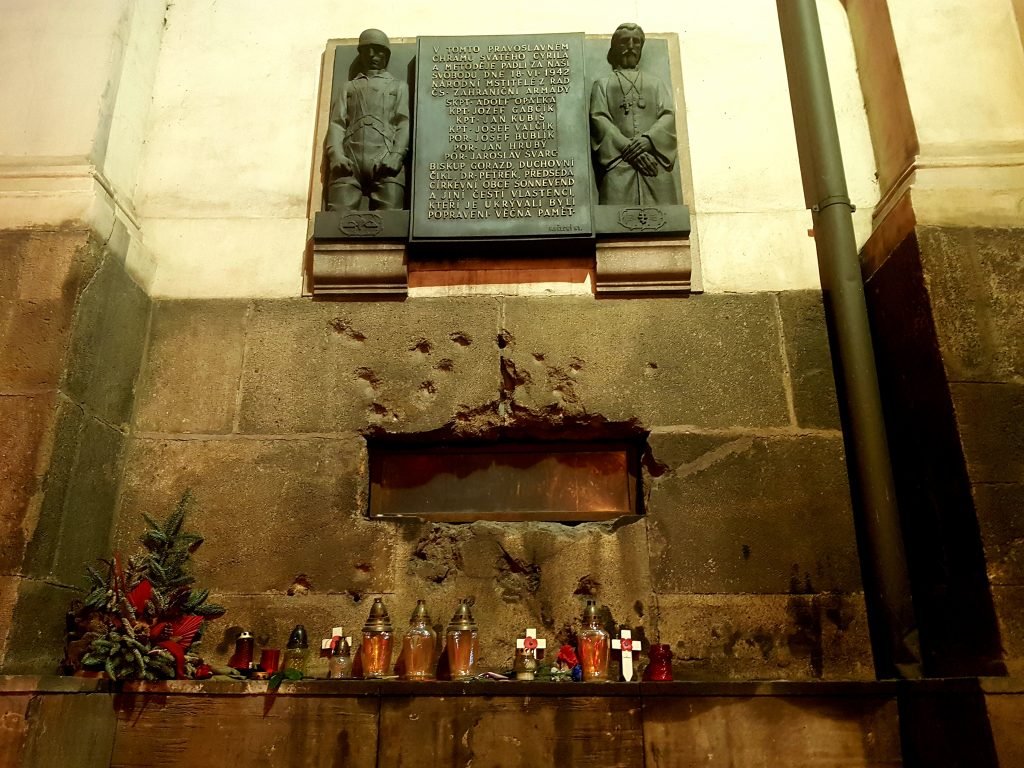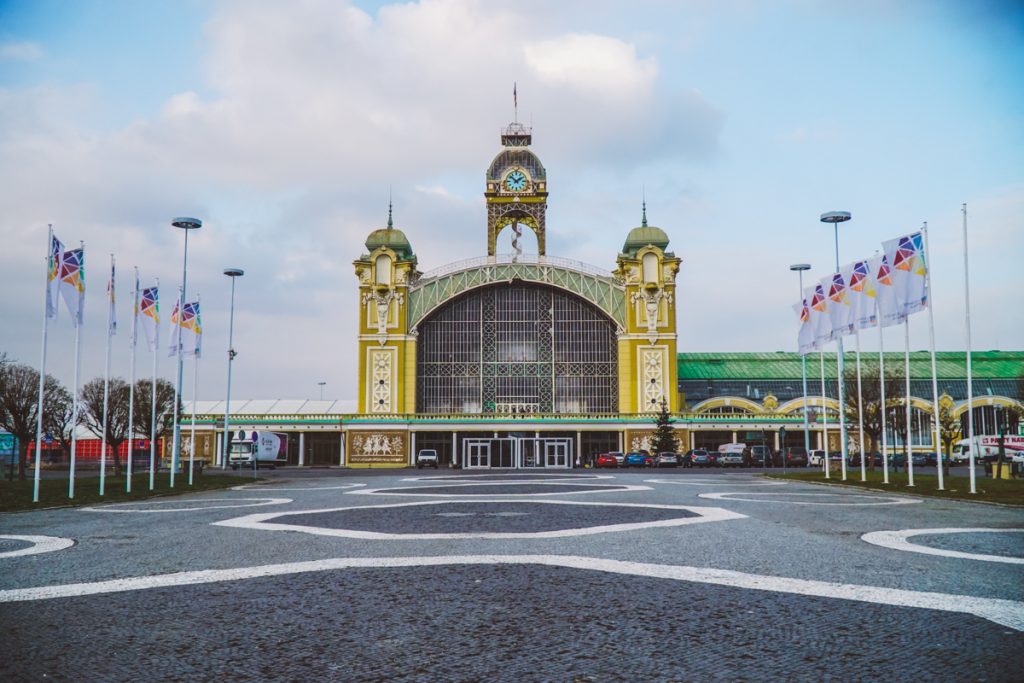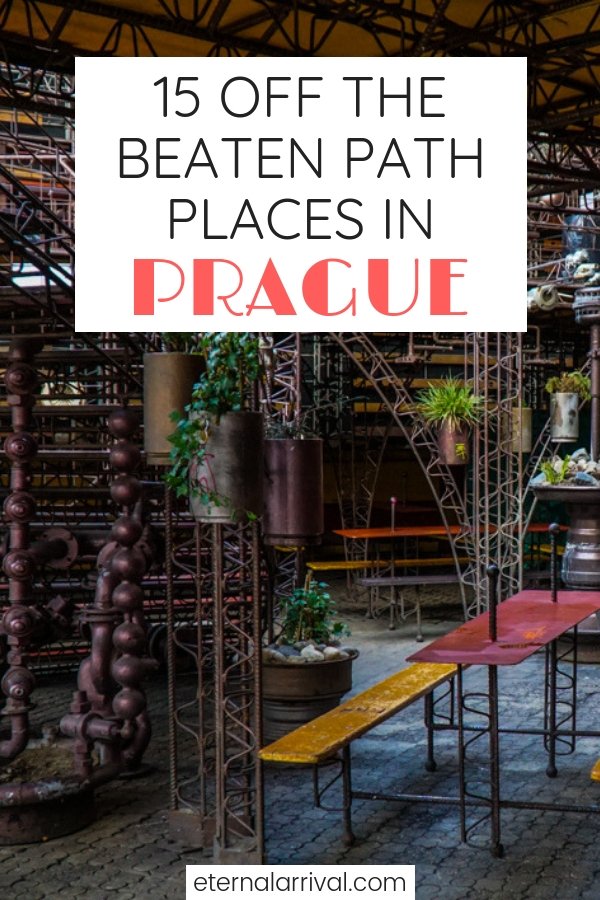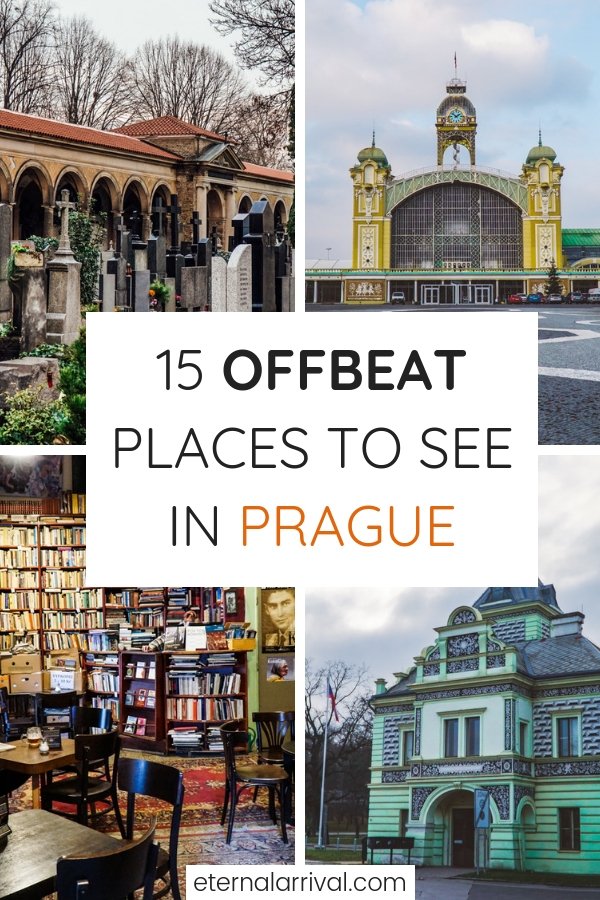After living in Prague and experiencing it in both summer and winter, I’m a huge fan of both — and I will defend Prague in winter as a perfect Christmas destination to the death.
See, Prague will always hold a special place in my heart, since that’s where I studied abroad in my junior year at NYU.
I dove enthusiastically into life in Prague, learning (okay, butchering) Czech, eating ridiculous amounts of česnečka (a delicious garlic soup), and confirming the propaganda that Prague is, indeed, a place where beer is cheaper than water.
I didn’t know it at the time, but living in Prague that semester would change my life — it’s one of the essential stepping stones that brought me to a travel blogging career.
| ⌛ Planning your wintery Prague trip in a hurry? Here are my quick picks. ❄️ Best Prague Winter Experiences 1. 4-Hour Czech Food Tour of Prague 2. Prague Castle Skip-the-Line Entry and Tour 3. Czech Beer Bath & Spa Experience For Two 4. Private Vintage Car Tour 🏰 Best Winter Day Trips from Prague 1. Day Trip to Fairytale Town of Cesky Krumlov 2. Bone Chapel and Kutna Hora UNESCO Site Day Trip 🛏️ Best Prague Hotels 1. Le Palais Art Hotel (boutique hotel that feels like an art gallery) 2. Czech Inn (budget-friendly design hostel with fun social scene!) 3. Aria Hotel (ultra-luxurious hotel with unique music theme Arriving in Prague by plane? Book your affordable airport taxi with Welcome Pickups here and avoid any headaches or scams. |
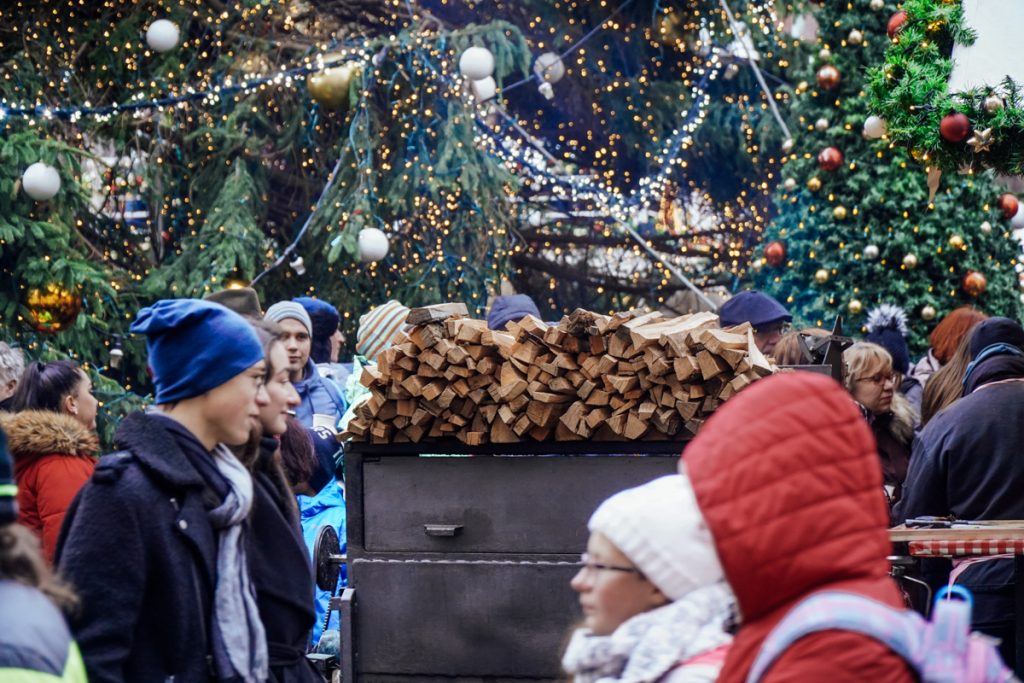
It was the catalyst that brought me to Europe, time and again, and sparked my love in particular for post-communist Central and Eastern European countries.
It got me deeply interested in Slavic languages, which would later be convenient when I moved to Bulgaria eight years later.
Still, it wasn’t all roses. I fell in love with summer beer gardens and fall young wine harvests, but winter took me a while to come around on.
While I loved living in Prague, I was taken aback by how insanely cold Prague was in winter.
Even after having survived my first two winters in New York, if it weren’t for svařák (hot mulled wine) and medovina (hot honey mead) on the street corners, I likely never would have left my Prague dorm in winter.
I eventually came around and learned to love Prague in the winter for what it was — festive, dripping with charm, and the best time to eat a bunch of delicious Czech food!
Things to Do in Prague in Winter
Browse the Prague Christmas Markets
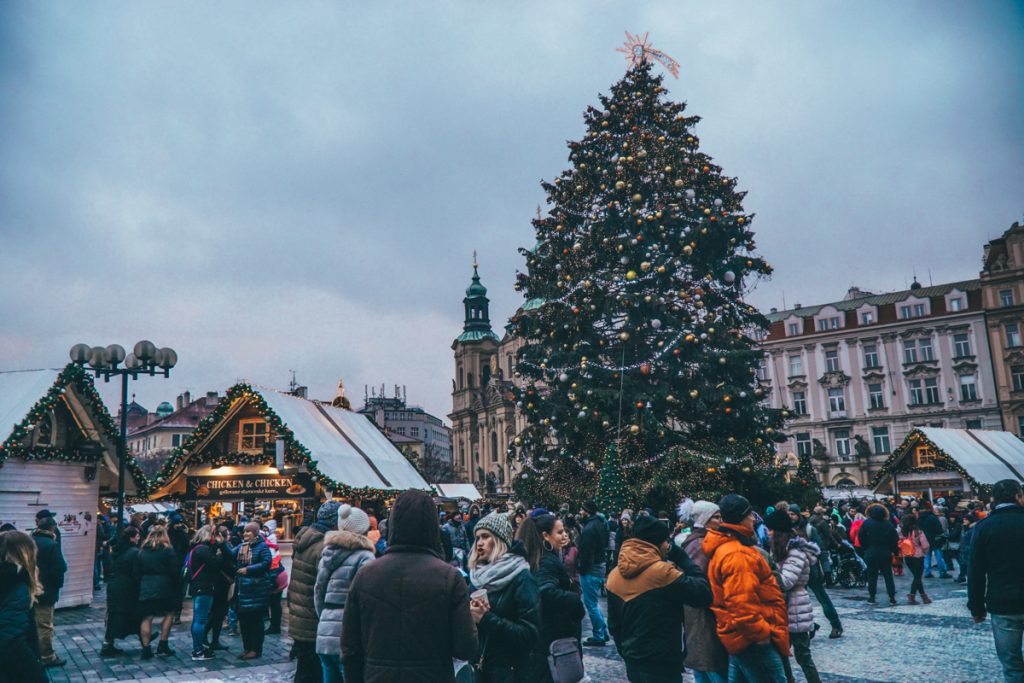
If your Prague winter trip happens to overlap with the Christmas markets, you’re in luck – this is one of the best times of year to visit Prague!
However, keep in mind that you’ll also be among several thousand of your closest tourist friends.
Prague in December and early January is peak winter season (Prague empties out again in mid January and
Despite the crowds in winter, Prague’s atmosphere – already charming and lovely – becomes even more festive.
You’ll be delighted as Czech meals and drinks are doled out by market vendors and craftspeople sell their Christmas-themed ornaments and trinkets, all clustered around an enormous, insanely blinged-out Christmas tree.
That said, on weekends, visiting the Old Town of Prague is especially chaotic.
While I found the main Christmas market area tolerable during the weekdays, it had me running for safe haven in a craft beer bar on the only Saturday I spent there.
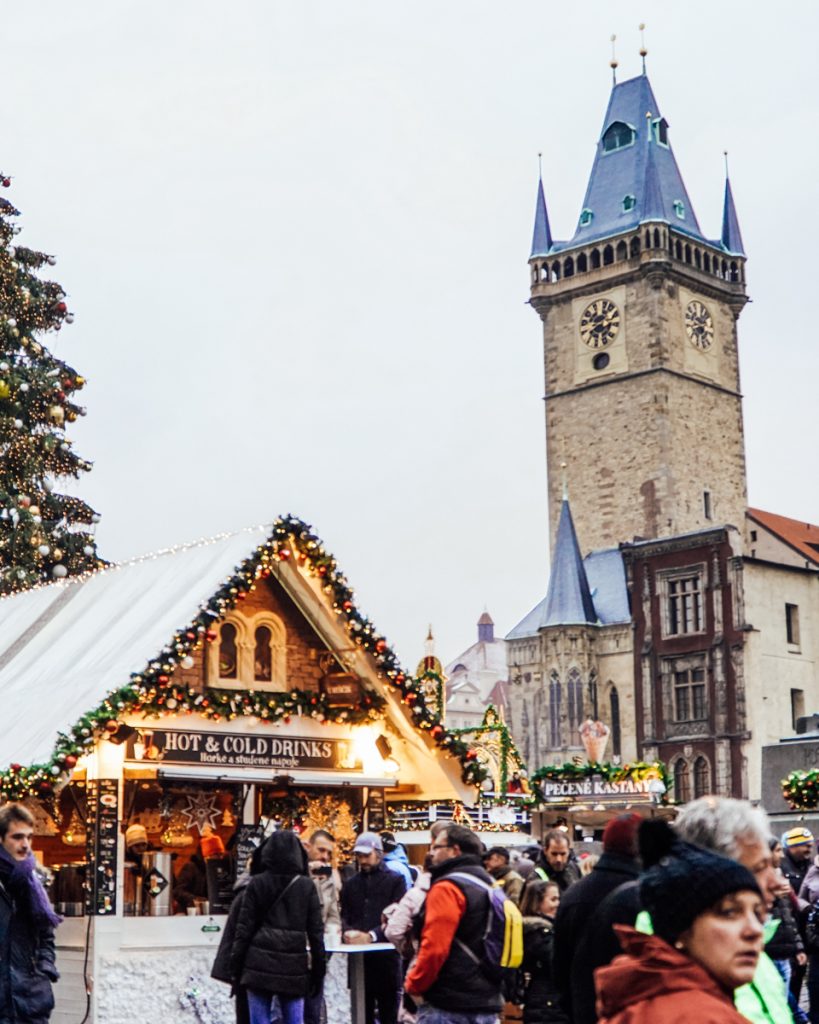
If you have a few days in Prague around Christmas and want to see the markets, I recommend spending your weekdays around the Old Town area.
On the weekends, visit off the beaten path parts of Prague or at least visit the less crowded Christmas markets.
To avoid crowds, I’d recommend the area around Jiřího z Poděbrad, Náměstí Míru, the markets just to the left when you cross the Charles Bridge in Malá Strana, and the area around Palladium Shopping Mall.
None are totally “offbeat,” but they won’t be nearly as crowded as the Old Town.
Insider Tip: If you’re visiting Prague in January, one added bonus is that the Christmas markets in Prague have one of the longer runs of all the Christmas markets in Europe!
The markets stay open weeks after Christmas and well into the New Year in order to coincide with Eastern Orthodox Christmas, which falls on January 7th.
The crowds will be reduced as many people don’t realize the markets run past Christmas!
One word of warning: Be very careful when visiting crowded Christmas Markets, especially on weekends when everyone from nearby cities comes in to enjoy the magic!
Unfortunately, it creates an atmosphere where pickpockets can work their magic easily, so keep aware of your belongings and make sure thieves can’t get you — that’s a sure way to ruin the Christmas spirit!
While travel in Europe is safe, pickpocketing is a major issue. Thwart would-be pickpocketers with a chic, sleek backpack with double-interlocking zippers, slash-proof construction, & RFID blockers! I’ve carried this PacSafe backpack to 30+ countries with me, and it’s my #1 travel companion. Pick from one of seven colors — I have and love the classic black one!
The main Christmas market is in Old Town Square (Staroměstské náměstí) and it’s definitely one you want to visit!
There are also smaller markets in Wenceslas Square (Václavské náměstí), Republic Square (Náměstí Republiky), and Peace Square (Náměstí Míru), as well as a few others around the city.
Fun fact – the escalator at Náměstí Míru is the longest escalator in
Note: The trdelník you see everywhere on Instagram is not traditional to Prague, but rather an import from Hungary, where they are called kürtőskalács– and ice cream is definitely not traditionally served with either!
If you’d like to taste a true Czech dessert, be sure to try fruit-filled dumplings, called ovocné knedlíky. It’s one of my favorite Czech treats and it’s ultra-traditional!
Explore the magical Prague Castle.
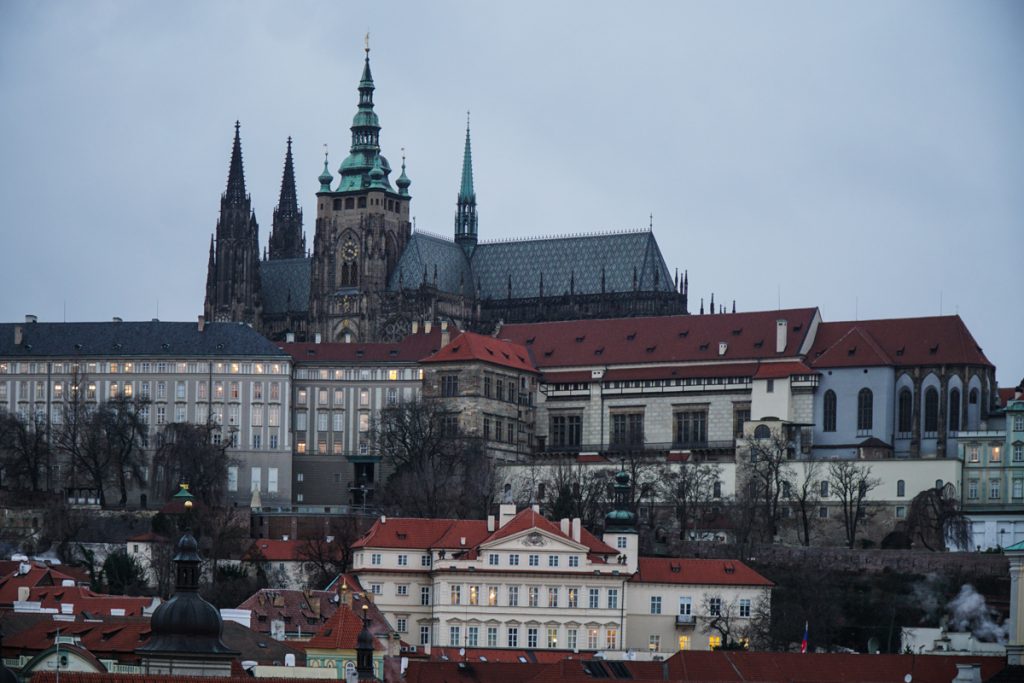
Ahh, Prague Castle. This place is a
But in the winter, Prague Castle is even more ridiculously gorgeous, especially if you’re lucky enough to see the city with a dusting of snow.
One of the biggest and most-loved castles in the world, Prague Castle is home to an enormous amount of history, secrets, and treasures, making it a worthwhile stop despite the crowds and price.
While visiting Prague Castle, you can’t miss the St. Vitus Cathedral, which is considered to be one of the most beautiful in the world, with gorgeous paintings and stained glass windows.
It’s truly majestic to visit, with an air that inspires an air of awe and silence, even as people around you photograph away madly.
The Old Palace Hall and Vladislav Hall, with its cheery yellow facade, are both lovely to visit and great places to take photos of the castle complex.

Finally, while you have your ticket for Prague Castle, don’t miss Golden Lane, a 16th-century row of houses owned by goldsmiths back several centuries ago.
Around 70 years ago they were painted in colorful hues, making it a much-loved photo spot for Instagrammers from around the world now.
Fun Fact: House number 22 used to be the home of Franz Kafka’s sister, and he lived and wrote here for two years! vSo if you’re a fan of his work, you should stop by here.
Pro tip: The Prague Castle has insane lines pretty much all day long, which grow to hellacious proportions if you visit Prague in December.
Save hours by booking a skip-the-line ticket and tour, which you can present on your mobile (no need to print!).
Additionally, if you buy a Prague City Card, admission is free, though it won’t include a skip-the-line ticket.
See some of the city’s best museums

While in summer it’s hard for me to drag myself to museums, in the winter it’s a whole different story!
I love visiting museums in the winter in Prague!
That’s because my California ass can’t handle the cold, and I don’t like to go more than a few hours walking around if temperatures are below freezing
The National Museum (Národní
However, lines have been insane since reopening – according to my food tour guide, up to two hours at peak times.
So be prepared to abandon ship and check out one of the other museums instead. Instead, visit another one of Prague’s excellent museums.
One of my favorite museums in Prague, and a must for any literature
Finally, if you’re into weird and quirky museums, Prague seems to specialize in them.
There’s a Museum of Alchemists and Magicians, a Museum of Historical Chamber Pots and Toilets, and an Apple Museum – for whatever reason.
If you’re into finding the weirder side of a city, I recommend checking out the Atlas Obscura for Prague, which does not disappoint.
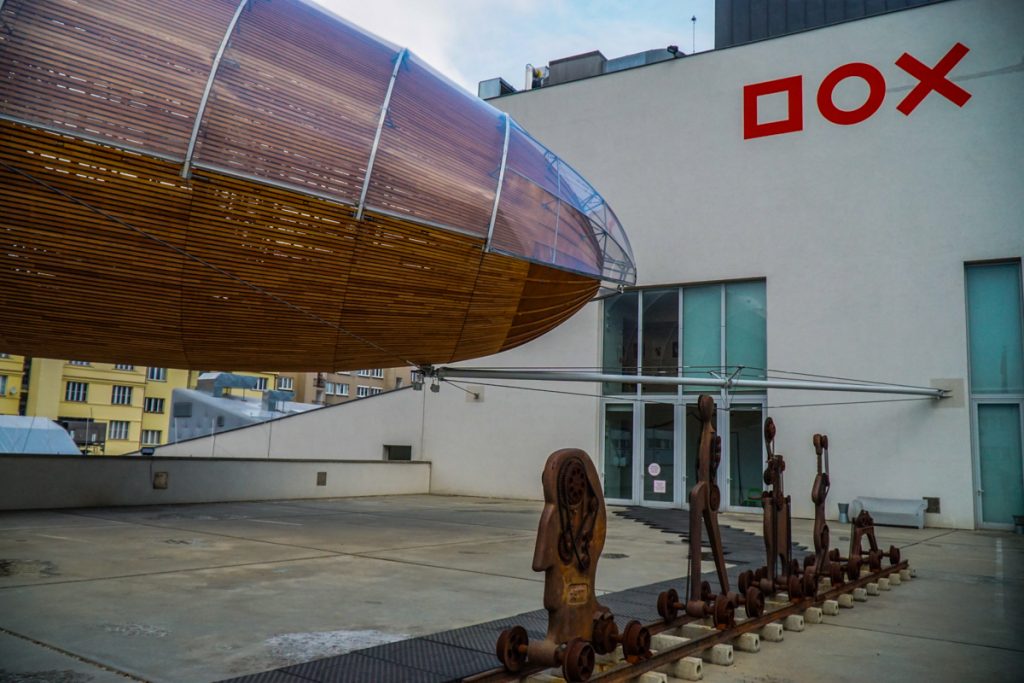
Prague also has some excellent contemporary art museums.
I visited the DOX Museum of Contemporary Art recently and absolutely loved it.
It was incredibly thought provoking – I especially loved their exhibition on data and privacy.
Skip the tourist trap museums: Museum of Senses, Museum of Sex Machines, Museum of Torture, etc.
They’re kitschy (but not in a good way), not worth the money, and filled with other tourists.
Catch a surprisingly affordable show
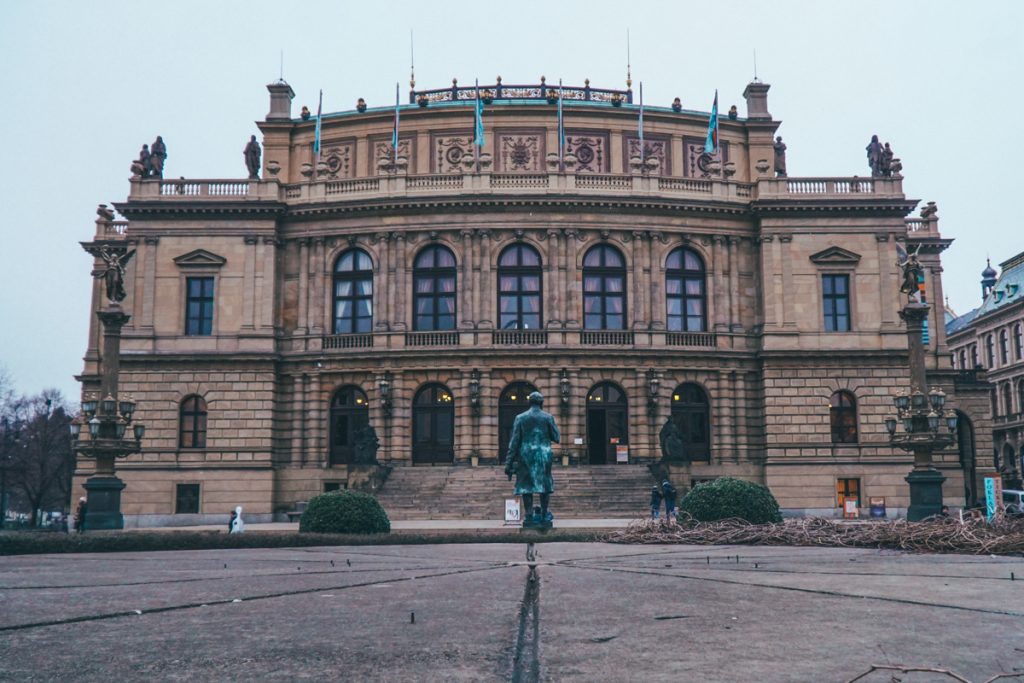
2023 Update: The Prague State Opera finished its renovations in January this year, so it’s now reopen for the 2023-2024 winter season! Check out what’s on here.
You can also see opera at the Karlin in Prague! I haven’t visited this theater personally, but it is the second largest in Prague and over 100 years old and is supposed to be beautifully done in the traditional Baroque style.
If you had told 17-year-old me that 19-year-old me would be going to the opera in Prague, I’d definitely have snort-laughed in your face.
The reality is that going to an opera in Prague feels like going to an insanely luxe event that you’re definitely underdressed for, when in fact it is perfectly affordable, even on a student budget.
While I’d reckon a guess that the opera has gotten a bit pricier since I attended a performance of Carmen a decade ago, it’s not by much (and I paid less than $10 USD for my floor-level ticket).
While I’m not necessarily an opera enthusiast, there’s no denying that it’s a magical atmosphere, both in terms of the wonder in the air that accompanies every live performance but also the adornments of the opera house that surround you.
Recently reopened after years of renovations, the Prague Opera House is truly stunning, ornate with the kind of grandeur that made my American self go slack-jawed taking in all the traditionally grand European details and flourishes.
If you’re worried about not understanding the opera, don’t worry – even back in 2009, the Prague Opera was ridiculously modern and had subtitles in three different languages (English, Czech, and German) so that you could follow along.
Attend a classical concert or ballet in Prague.
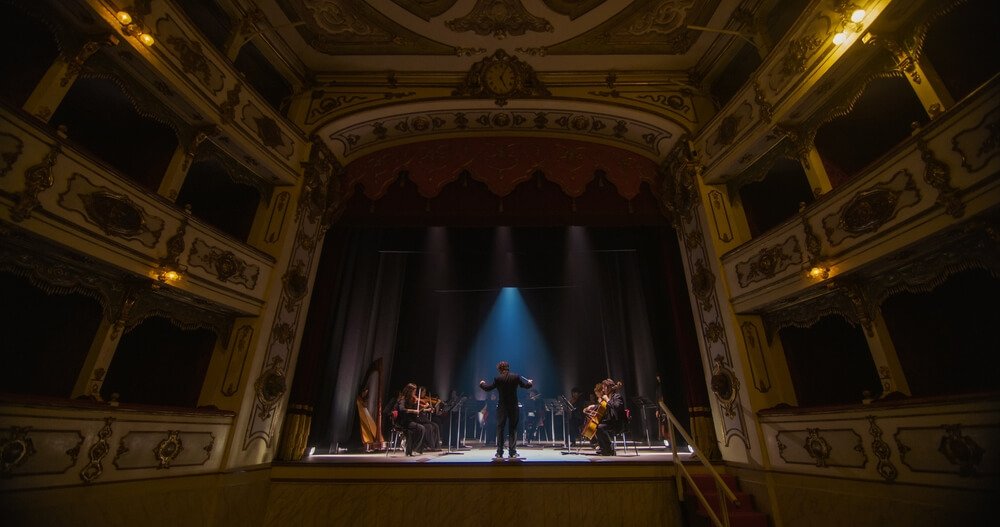
Since Prague is so cold in the winter, it’s great to have affordable (indoors) arts at your fingertips.
Operas aren’t isn’t the only performance worth visiting in Prague to escape the winter weather.
Here are a few other recommendations!
The Lobkowicz Palace in Prague Castle has a 1-hour classical museum performance every day at noon.
Tip: Be sure to book it on the day you are visiting the Prague Castle so you don’t have to pay for admission twice (admission to the castle is not included in the concert ticket).
The
Be sure to book in advance as some days have already started selling out this winter.
Another more swanky option is an Mozart ballroom performance and 3-course dinner!
This takes place at the Boccaccio Ballroom, part of the Grand Hotel Bohemia.
Again, I recommend pre-booking your ticket as it is a popular option.
Warm up with a perfectly poured Czech beer
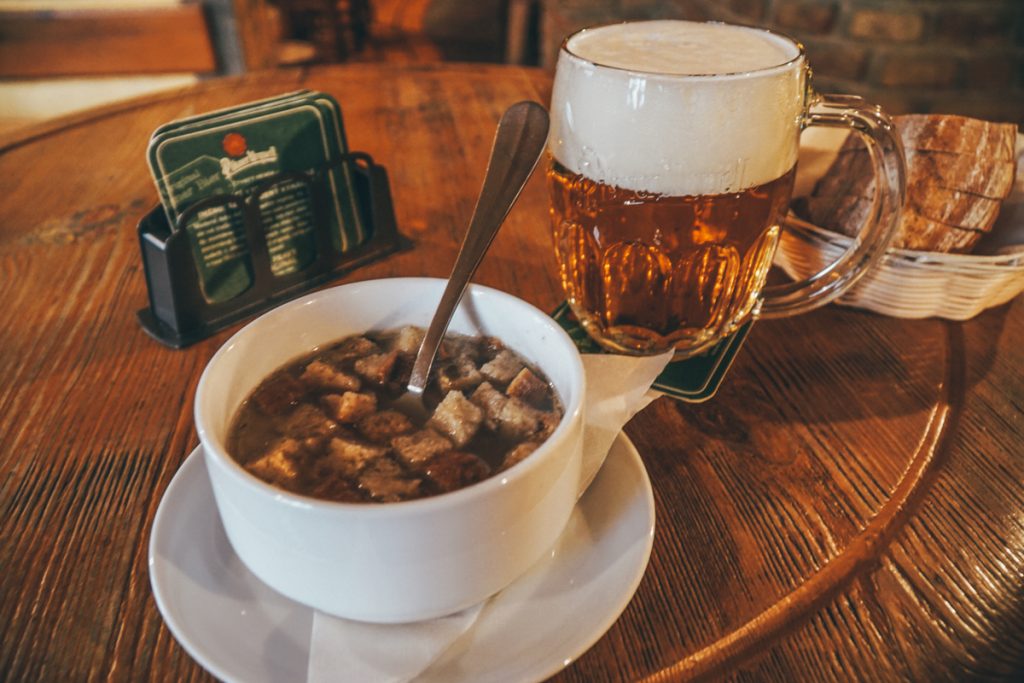
While in the summer, you’ll find Prague locals practically glued to their seats in the outdoor beer gardens throughout the city, Prague in winter is definitely more indoor-oriented — though generally with just as much beer.
Yes, for better or worse, the Czech Republic is synonymous with beer.
While this brings an abundance of the infamous “lads on tour” who just want a cheap drinking holiday, beer is also an inextricable part of most Czechs daily lives, so indulge away – it’s just part of getting cultured, right?
The Czech Republic is best known for creating pilsener, a pale lager which is now one of the most common types of beer you’ll find around the world, just
There’s nothing like drinking Pilsner Urquell (the original pilsener) straight from the tank less than 100 kilometers from where it was brewed!

There are countless bars and taprooms you can go to experience about Czech beer firsthand.
I’m a sucker for nostalgia and history, so my favorite is U Pinkasu, where the first Pilsner Urquell was tapped — see the sign above!
Note that a properly poured Pilsner has a lot more foam than you’re probably used to – about 3 fingers or 2 inches of foam.
This is the mark of a correctly poured beer so don’t make a fool of yourself by complaining! Just try it – it’s absolutely delicious.
Visit the Czech Beer Museum.
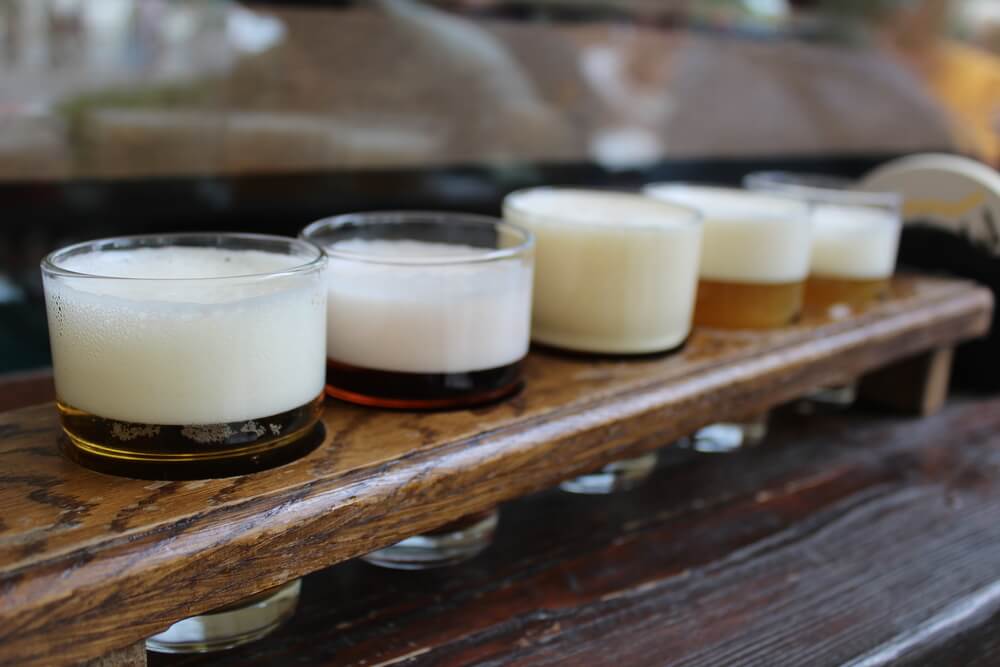
If you want to understand the history of beer brewing in the Czech Republic, I recommend a visit to the Czech Beer Museum.
It’s small, but it’s also entertaining and informative…
… but maybe most importantly, you get 4 two-deciliter samples of beer at the end included in the price of admission (for research, of course.)
And for the truly extra amongst us, you can actually leave the museum with your own personally customized beer bottle!
This also makes a great Christmas gift for a beer fan back home.
This tour includes museum entry, a guided tour, 4 samples, and your own custom bottle to take home.
Book your online ticket here (no need to print – you can present it on mobile!)
Taste Czech wines at a local wine bar
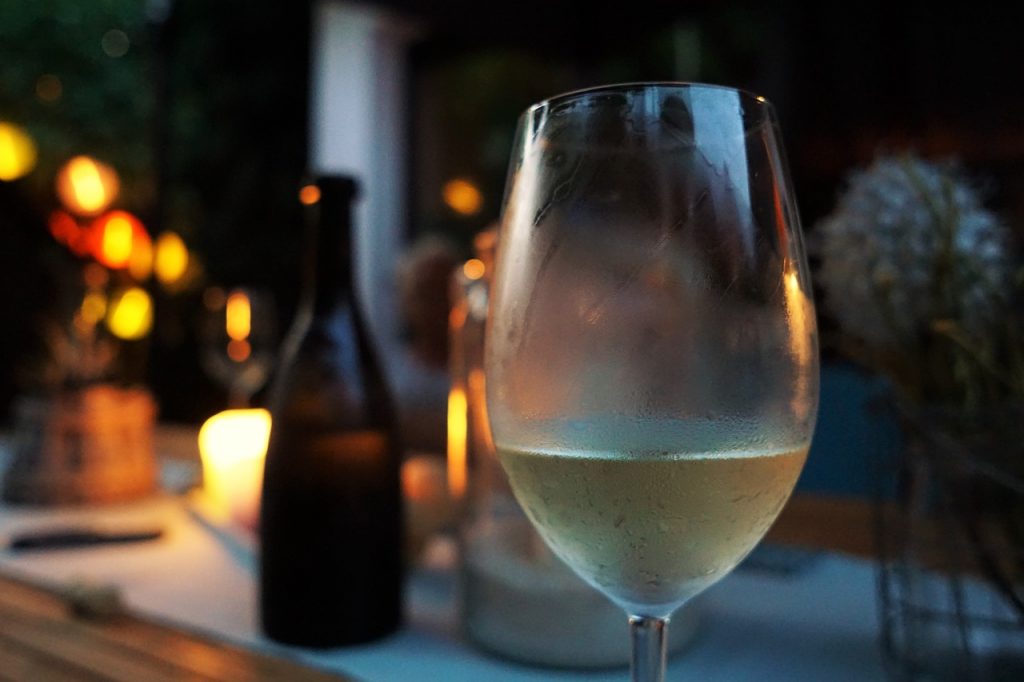
Yes, I’m aware that putting three alcohol-related things so close to each other on this guide may make me out to be a bit of an alcoholic.
I truly can’t help myself in Prague – the beer and wine are just so good!
While many people know about the vibrant Czech beer scene, few people know just how delicious Czech wine is.
Even fewer people know that a huge swath of central Prague used to be vineyards – Vinohrady, the neighborhood I lived in when I lived in Prague.
I have a huge soft spot for burčák, the Czech young wine that tastes almost like apple cider and according to local lore, continues to ferment in your stomach (resulting in surprise hangovers).
Still, Prague still has a ton of wine options that are better suited for the season.
While the Czech Republic is best known for its excellent white wines, you can find some great red wines as well, if that is more your speed.
I tend to prefer Welschriesling (
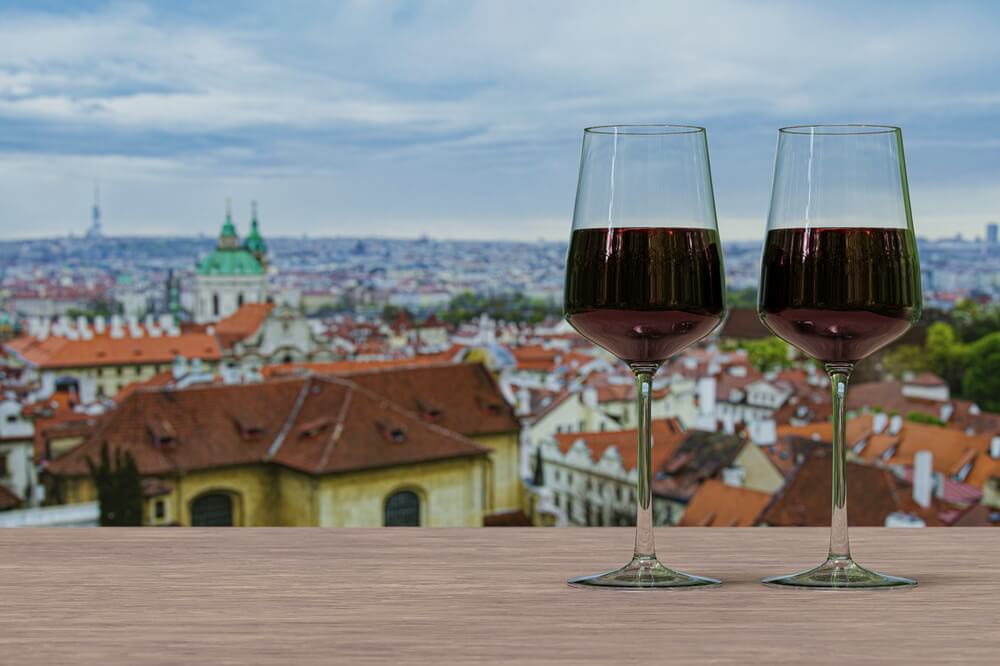
If you’re familiar with German and Austrian wines, Czech wines use a lot of similar grapes but to me, a Czech wine still is very different than its neighbors.
There are several wine bars in Prague worth visiting, and luckily, wine by the glass – while not as cheap as beer – is quite affordable in Prague as it’s not considered a luxury to have a good glass of wine.
Czech wines are rarely exported outside the county, so you might as well try it while you’re in Prague this winter if you’re a fan of wine!
My favorite neighborhoods to drink in are lovely Vinohrady and trendy Žižkov, which have a nice blend of catering to their local communities while still being centrally located.
Prices are more affordable here than in the area around Old Town, and it’s a lot less touristic.
My favorites are Vinotéka U Jiřího z Poděbrad on Přemyslovská 4 and U Posledního Soudu on Jagellonská 8.
Scale the Petřín Lookout Tower
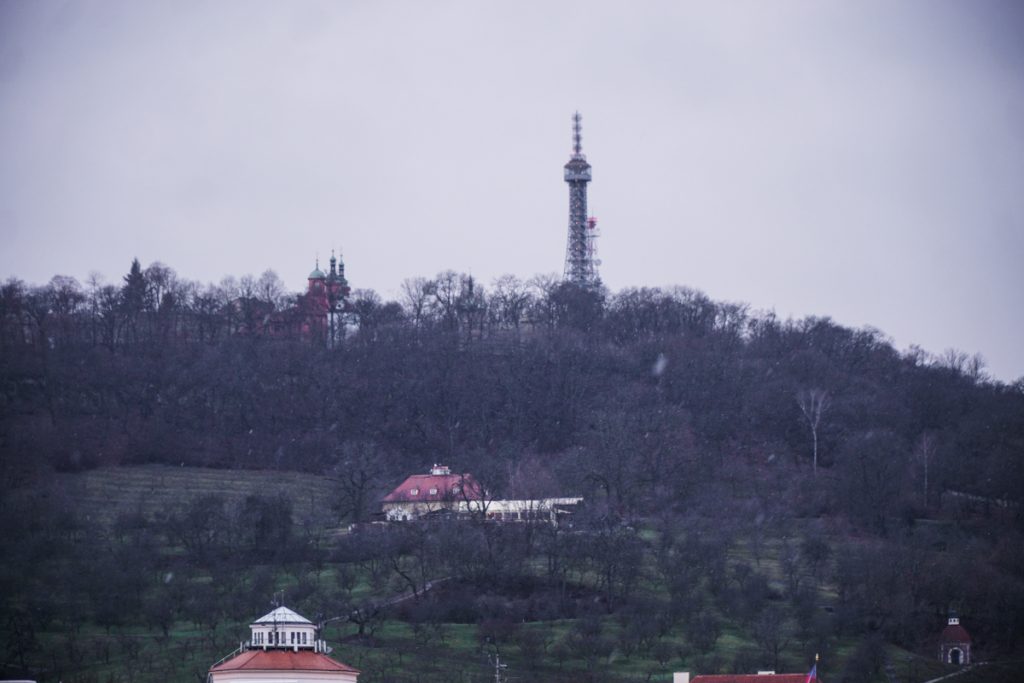
There are several places you can go in Prague to get fairytale-worthy views over the entire city but I have a soft spot for Petřín Hill and its lookout tower.
It’s a little quieter than some of the other popular lookout spots, like the Old Town Bridge Tower which is swarmed with people wanting that Instagram-perfect shot over Prague.
More than a hundred years ago, the Petřín Lookout Tower was conceived to be a replica of the Eiffel Tower, only smaller, at 63.5 meters tall.
It’s one step shy of 300 steps to the lookout point, but it’s well worth it.
Though I definitely don’t recommend going to Petrin right after a lot of beer, as those 299 steps will feel like quite a bit more… not that I speak from experience…
You can walk to the Petřín Lookout Tower from the Castle, which takes about half an hour, but it’s more popular (and more fun!) to take the Petřín Funicular.
At the top, you’re immediately rewarded with some of the most impressive sweeping views of Prague over the Castle District, Malá Strana, and the Old Town.
Stay warm while you sightsee in a vintage car tour.
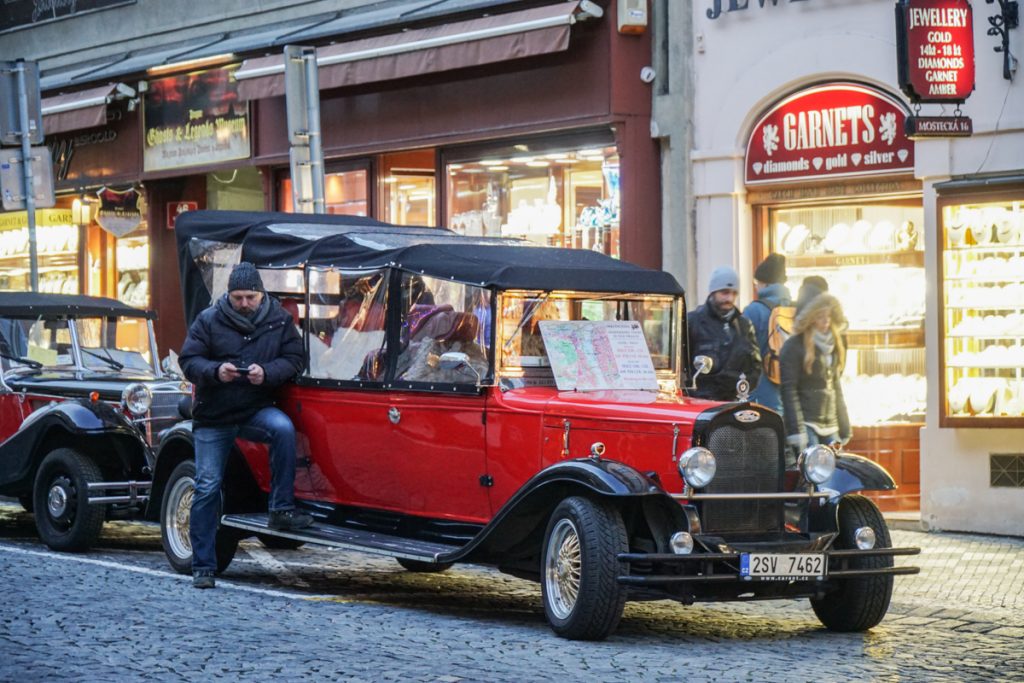
While there is no shortage of affordable or even free walking tours in Prague, in winter, you probably want to be indoors as much as possible.
So, compromise on a city tour of Prague with a private tour in a vintage car (don’t worry, the cars have heating, blankets, and even removable flap windows to keep out the cold in the winter!)
You can ride around the city in classic vintage cars, which fit up a group up to five people, in cozy comfort – all the while getting insight from a local on their city on a your 1.5 hour drive through the city.
If the car tour is for a special occasion, you can even add certain romantic touches like roses and French champagne – fancy.
Stroll the Charles Bridge over the Vltava.

From the Old Town side of Charles’ Bridge to Prague Castle is a quick 30-minute walk among some of the most charming buildings in the city, making the Charles Bridge an indispensable part of any Prague winter itinerary.
I have a soft spot for the Charles’ Bridge as it made quite an impact on my life – literally, as my boat captain (who I assume must
Luckily, the bridge seems to have taken this hit in stride as it’s still standing, still as beautiful as ever.
Also known by its local name (Karlov Most), this medieval bridge is one of Prague’s most unique landmarks and has seen a lot throughout the centuries.
Its central position connecting Prague’s Old Town with the castle district means that Charles’ Bridge is nearly impossible to avoid during your stay and given how beautiful it is, why would you want to avoid it?
Yes, it’s crowded, and yes, it’s touristy, but it’s also one of the most beautiful places in Prague, in winter or summer.
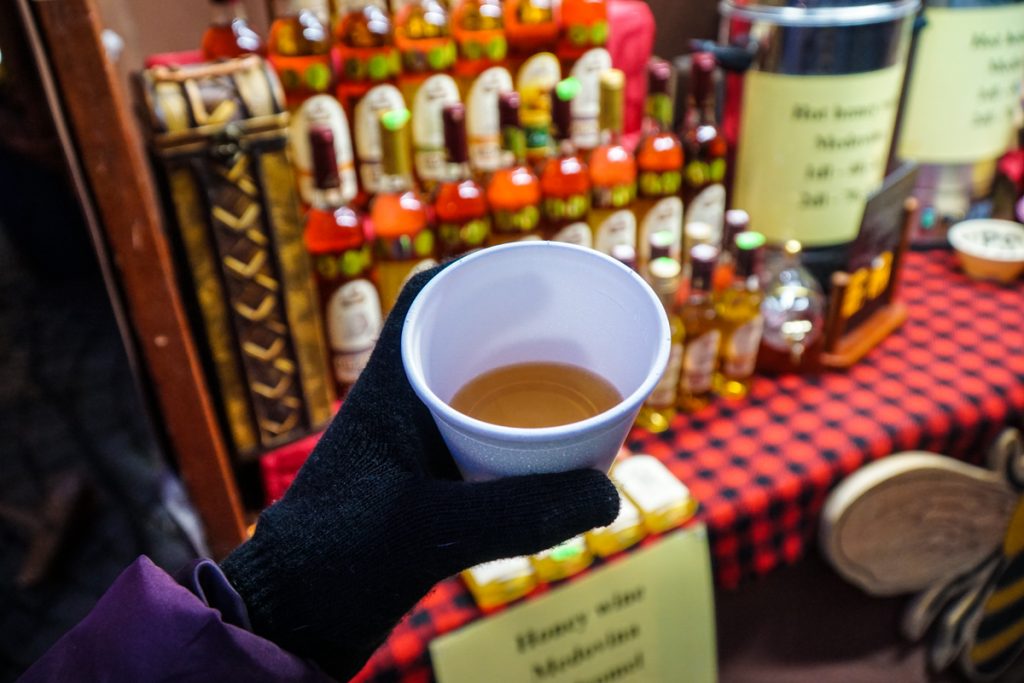
My top tip for seeing Charles’ Bridge in winter is to walk across it with a steaming hot cup of mulled wine, called svařák, or if you want something sweeter, some
There’s nothing quite like holding a warm drink in your begloved hands as you gaze over the unparalleled Vltava River.
Merely crossing this bridge over the Vltava River among all the statues covered in snow was so magical I barely even noticed the cold… though that might have been all the
Enjoy Czech food at a medieval-themed banquet.

Czech food is often written off as heavy and dull, and I’m here with an impassioned plea to reconsider!
I absolutely adore Czech food, although I will readily admit that it is not the healthiest nor the most vegetarian or vegan-friendly cuisine. It is, however, a fantastic way to warm up in the Prague winter!
A few of my favorite traditional Czech dishes include guláš s knedlíky (Czech-style goulash stew with handmade sliced bread dumplings), vepřo-
If you want a stick-to-your-ribs winter meal, go for a medieval-themed dinner, drinks, and show.
You can opt between 3 and 5 courses, and it comes with – of course, this being the check republic – unlimited beer (or wine should you choose), and hours of entertainment!
It also has plenty of medieval-themed entertainment – from swordsmen to jugglers and more – which makes it perfect for families or those looking to have a really immersive and unique dinner experience.
It also has vegan, vegetarian, pescetarian, and gluten-free options (in addition to meat and poultry) so it has options to suit just about every dietary requirement.
The medieval dinner is one of the most popular things to do in Prague in winter, so I strongly suggest pre-booking if it’s on your Prague bucket list! Check menu options and make a booking here.
Eat alllll the food on a Czech food tour.
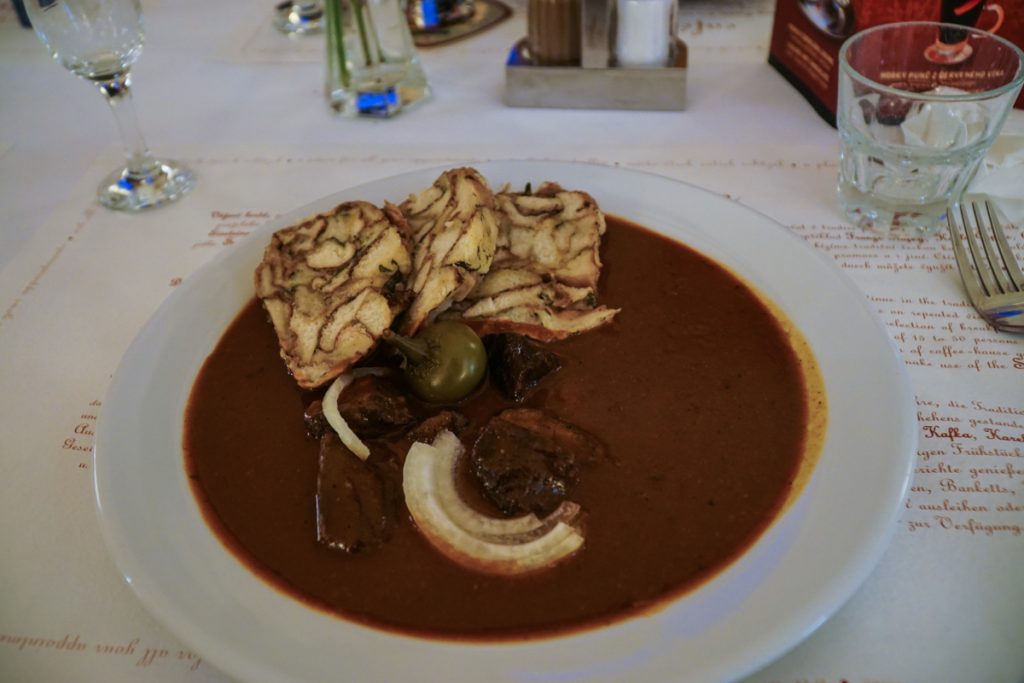
Another fantastic thing to do in Prague in the winter
I did a food tour when I visited Prague in December and I absolutely loved it.
Even though I was quite familiar with Czech food, having lived there a decade ago, it was delightful to see all the best of Czech food represented in a filling, well-paced 4-hour food tour.
Take it from me, someone who ate pretty much nothing but Czech food for six months: it’s a perfect introduction to Czech cuisine to those who have a limited time to discover it.
On the tour, we tried 3 traditional pastries, a selection of meats, a selection of mini open-faced sandwiches called chlebíčky, an appetizer, a soup, a main dish, and an apple strudel for dessert.
I don’t want to spoil what all the delicious things we tried were, but trust me when I tell you that you should definitely skip lunch and you’ll be hard-pressed to find room after dinner.
Pro Tip: I always schedule my food tour for the first day I arrive in a city — that way, every dish is new to me, I know what my favorites are when I go to a restaurant afterwards.
The best part though is that I can badger the tour guide for more restaurant recommendations!
This is the exact tour I took, which I highly recommend – my guide was fantastic, and all the food we tried was so good!
Go ice skating in Ovocný Trh.
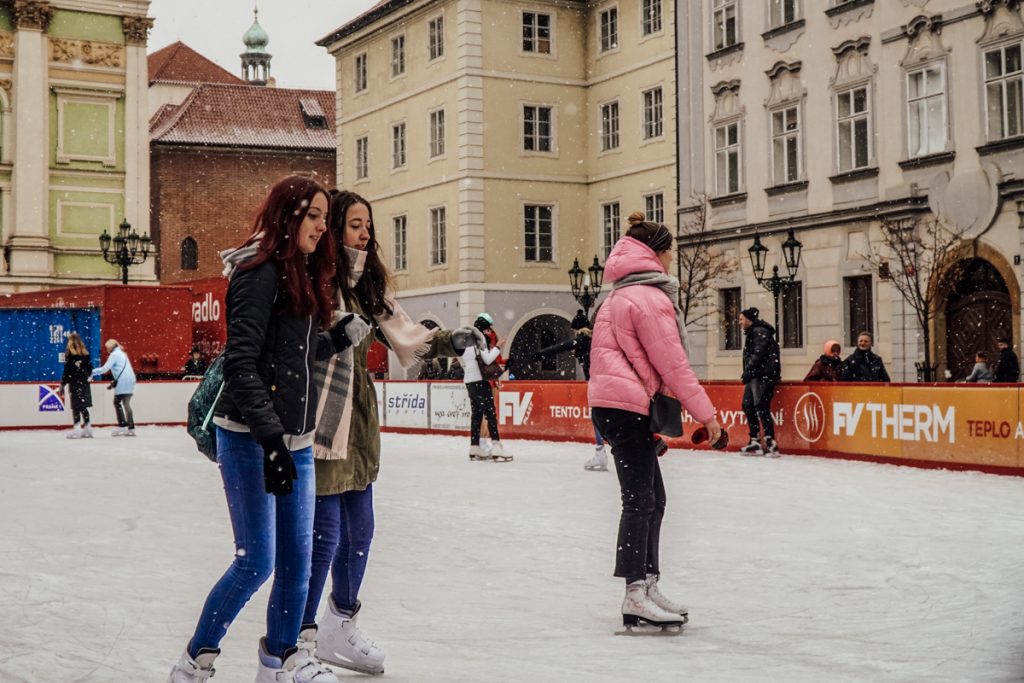
Is it even a European winter trip if you don’t go ice skating?
Ice skating is one of the most-loved winter pastimes, and when you combine it with the historic spot of Ovocný Trh it becomes even better.
This ice rink is found behind the Czech Estates, and even though it’s open for a relatively short time, it’s free for everyone during that time…
… Though in practice, since you will likely have to rent skates unless you’re the kind of person that has ice skates in their suitcase (weird flex, but okay).
However, even skate rental is rather affordable – about 100 CZK per hour, around $5 USD.
Despite the prime location, it was never crowded when I walked past it, even on the weekend.
It’s a great place to while away some time (and if you need to warm up, it being Prague, there’s a mulled wine booth just a few meters away from the rink).
Take a cruise on the Vltava River
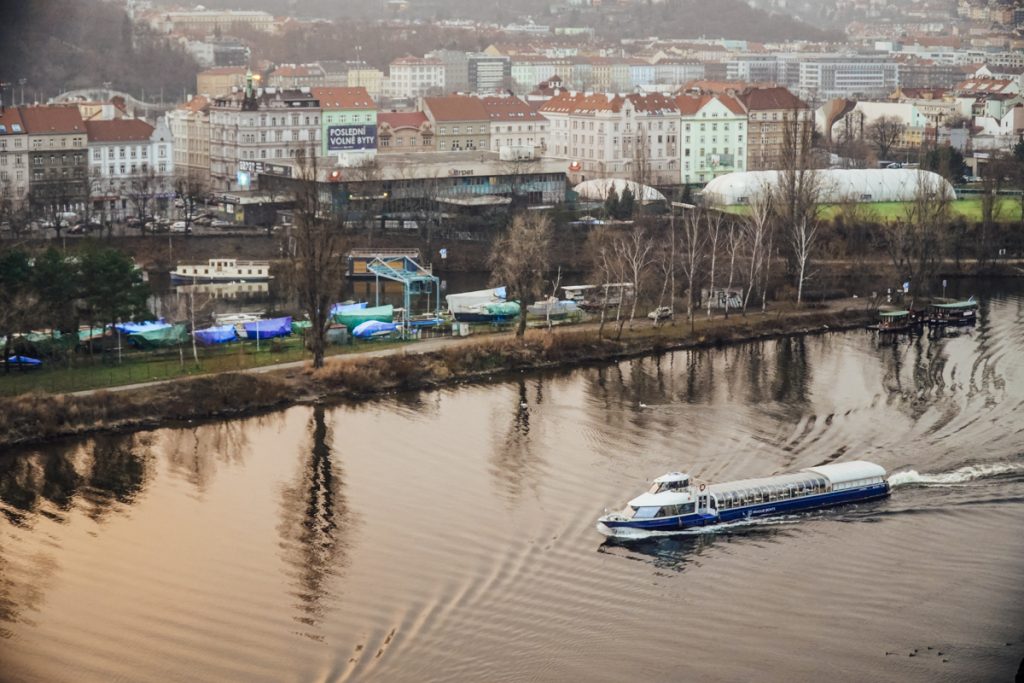
While
There’s something magical about cities built on water and seeing it from water level adds a new dimension to a place you’ve traversed several times on foot.
Just as my boat trip on the Danube was a highlight of my Budapest trip, a cruise on the Vltava River is a must on any Prague winter trip.
The boats are fitted with glass so you don’t have to worry about being too cold as you zip up and down the Vltava river, passing views such as the Prague Castle and passing underneath (and hopefully not into) the Charles Bridge.
If you’re cold, you can warm up while holding a drink and taking in the information presented by your guide, who will explain the current function of the historic buildings as well as their unique pasts.
The best option would be the 3-hour cruise, including a buffet dinner of tasty Czech food, all with a background of lovely live music, which you can book here.
The boat cruise departs at 7 PM during the winter months and cruises for 3 hours, so you can see Prague beautifully lit up at night.
Take a sauna on the river
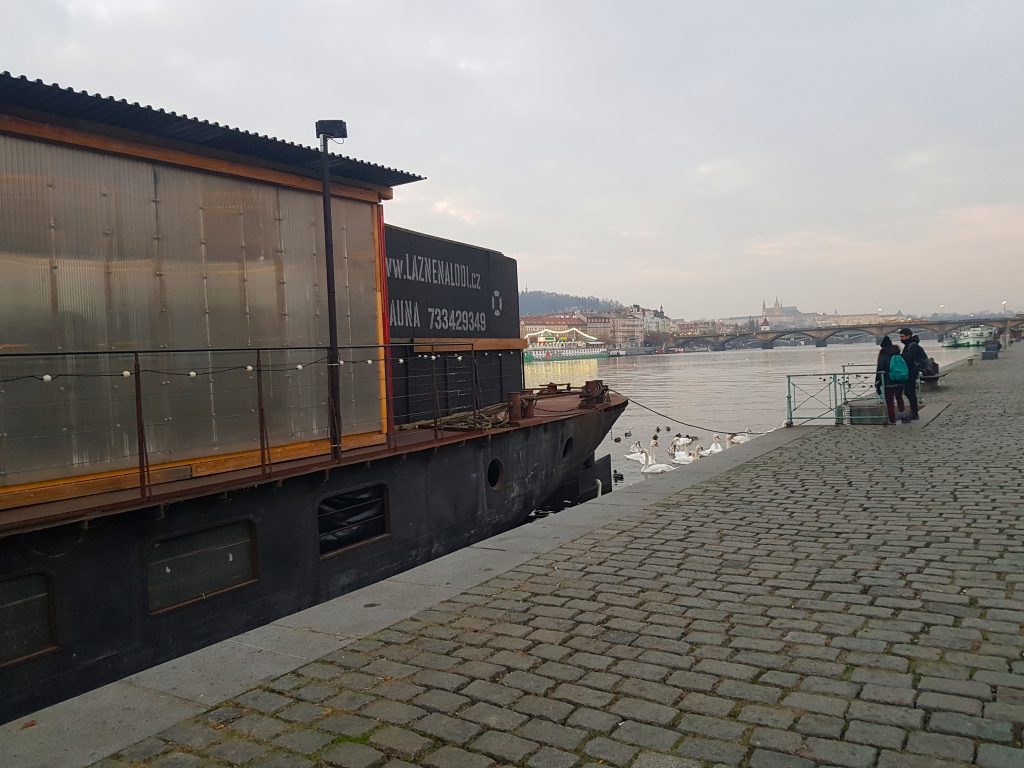
If you want to get a bit away from the Christmas market crowds and warm up in an unconditional manner, head to the Naplavka Riverbank under the shadow of the Vysehrad fortifications.
This river walkway is lively and often likened to a beach party in the summer, but it’s extremely quiet and peaceful in the winter.
Since Prague’s weather in winter is rather arctic, just walking along the water is a bit chilly.
Instead, take advantage of the genius sauna-on-a-boat concept at Lázně
Here, for about $6 per hour (140 CZK) you can enjoy a peaceful sauna and even go for a dip in the freezing cold Vltava if you’re brave (or if you’re Finnish).
I recommend reserving a place if you really want to visit as it can get crowded at times.
An important note: this is an all-gender nude sauna, though people wear sheets to cover themselves, so if you’re shy this isn’t the place for you!
Visit a Prague beer spa.

Want an even quirkier spa experience that is something you can really only do in Prague?
Check out the beer spa featuring a beer bath and all you can drink beer!
It’s not cheap — it’s about $55 USD per person, and must be booked as a group of two – but it’s one of the most unique things you can do in Prague.
Escape on a day trip to Český Krumlov.
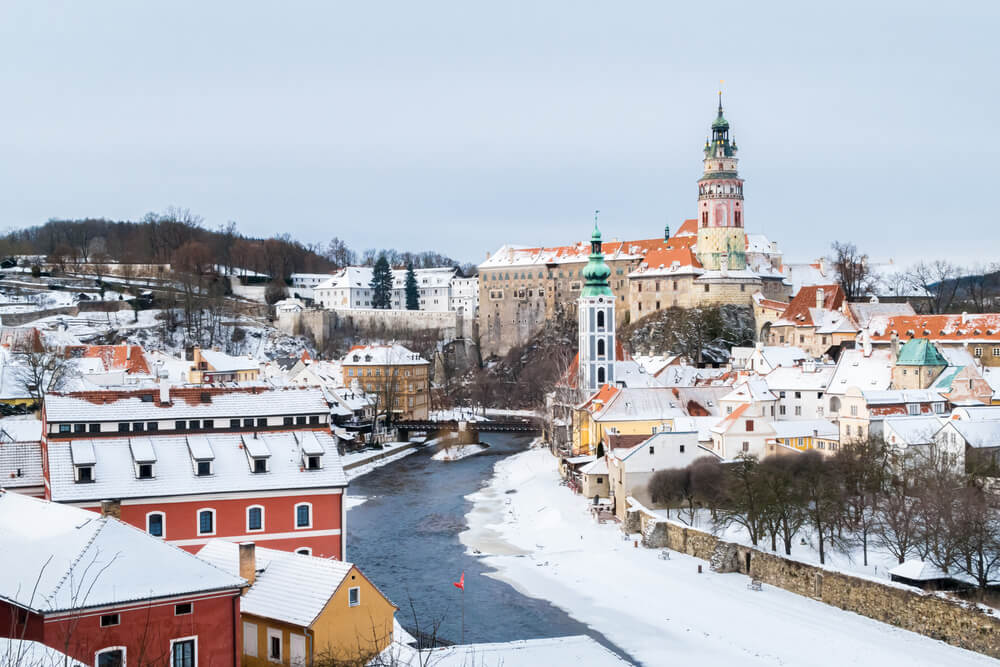
If Prague in winter just simply isn’t enough fairy-tale magic for you, you diva you, then hightail it to one of the most beautiful cities in the Czech Republic: Český Krumlov!
I have only been here in the fall but I can certify that it is absolutely delightful any time of year – and likely doubly so under a layer of snow!
Český Krumlov in winter is a delight, and it’s well worth saving one day of your Prague trip for it.
While you can certainly get there independently by train, you can also book a day tour from Prague which makes transportation a little easier.
This is especially helpful if you’re nervous about navigating public transit in a foreign country.
This is the day tour I recommend, with over 500 positive reviews!
Take a more offbeat visit to the Bone Church.
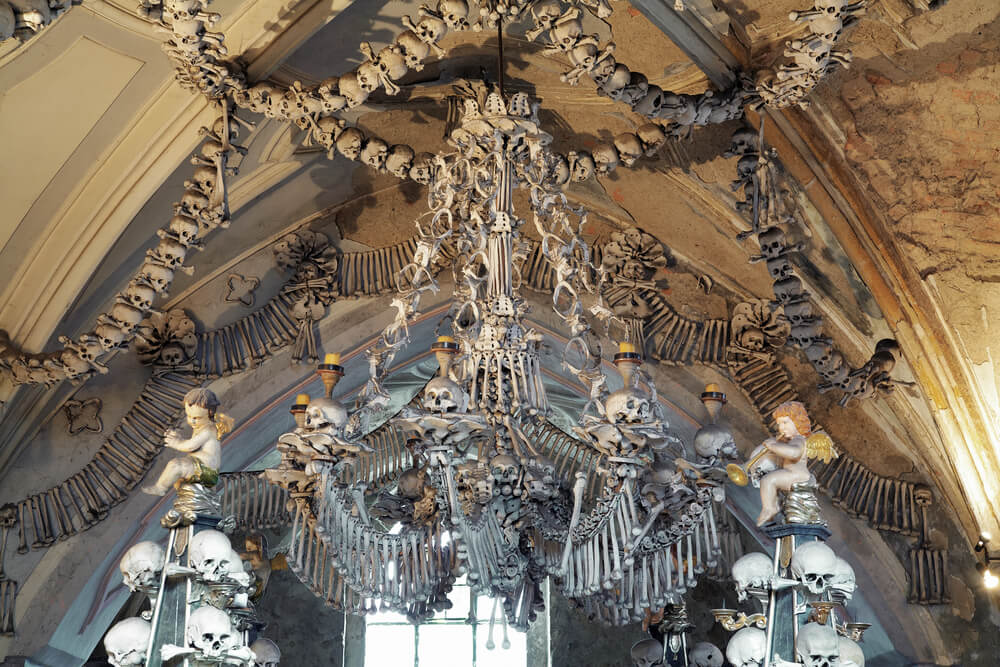
A cool but more macabre option is to visit Kutná Hora on a guided tour to see a picturesque Czech town with a bit of a dark side.
The town of Kutná Hora is most known for its famous “Bone Chapel,” better known as the Sedlec Ossuary, a UNESCO World Heritage site — composed of the bones of over 40,000 human skeletons!
The tour also includes Saint Barbara’s Church, Sankturin House, a beautiful Cistercian Monastery, the Italian Court, the Stone House, and the Plague Column.
You’ll really get quite a thorough overview of this unique and historic town about an hour outside of Prague.
This is the tour I recommend for Kutná Hora and its bone chapel, with over 800 positive reviews.
Is a Prague City Card worth it?
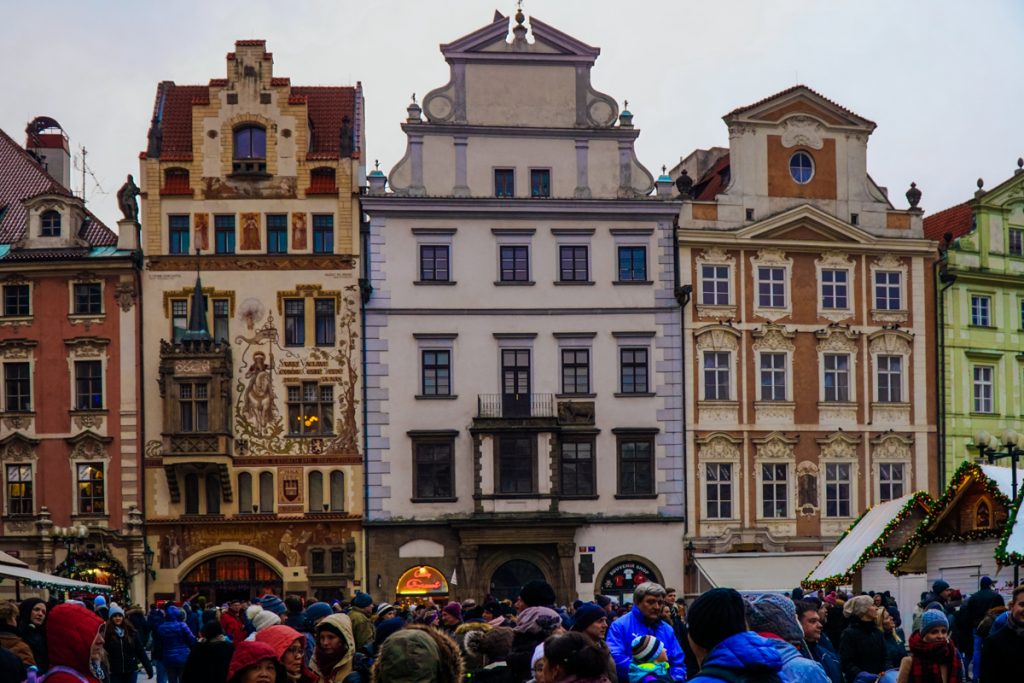
One thing many readers ask me is if the Prague City Card (now rebranded as the ‘CoolPass’) is worth it.
It’s available in 2, 3, and 4 day intervals, which allows for unlimited free public transit and included attractions.
If you plan to see the major sites in Prague – Prague Castle, the Jewish Museum and Old Jewish Cemetery, and the National Museum and Gallery – as well as do a river cruise, you will likely save money.
The Prague City Card offers the following options: a 2-day pass is about 60 euro, a 3-day pass is about 70 euro, and a 4-day pass is about 80 euro.
Considering that the Prague Castle entrance is about 14 euro, the Jewish Museum is about 14 euro, the Gallery is about 8 and the Museum is about 10, and a river cruise is minimum 15 euros…
… if you do all that, you’ve already saved money if you buy a Prague City Card.
Plus you get free transit, discounts on other attractions, and free access to at more than 50 other attractions.
I don’t always think city passes are worth it – but in Prague’s case, if you plan on doing the main sights, it 100% is.
To make it even easier, you can pre-book here and pick up the card and activate it whenever you arrive in Prague, picking up at one of three central points: Charles Bridge, Wenceslas Square, or the Florenc bus station.
Where to Stay in Prague
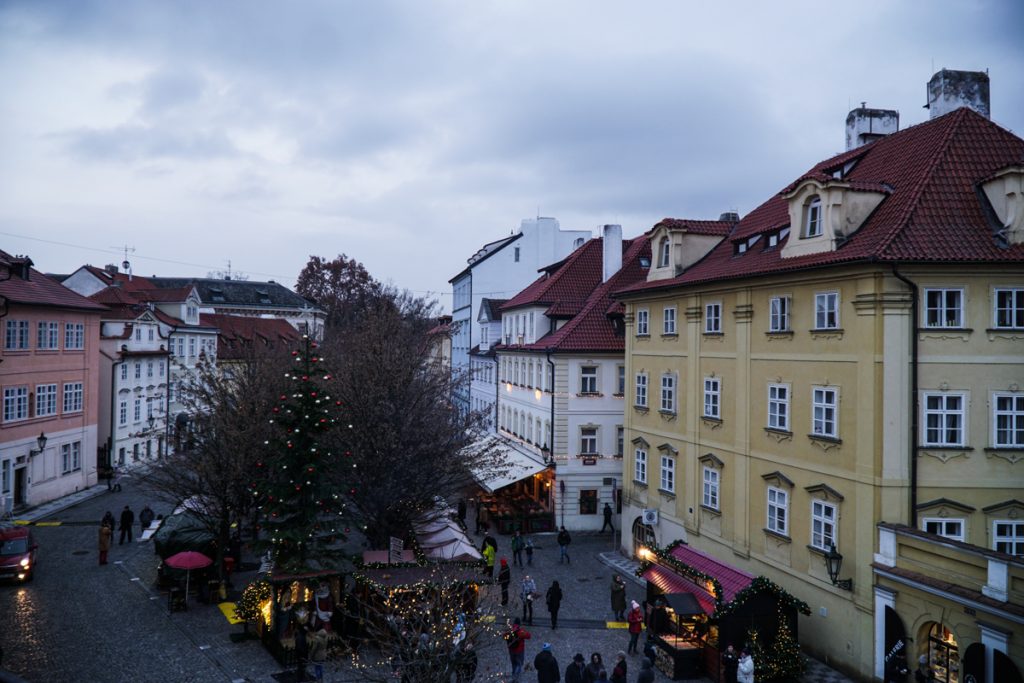
For tourists, Prague 1 and 2 are the most popular districts. I personally prefer the area around Vinohrady and the Old Town, though some people may prefer to be closer to the Castle District (Mala Strana)
I’ve noted my top picks for each type of traveler – budget, boutique, and luxury travelers – to make the hard choice a little easier!
Budget | Czech Inn
Combining beautifully European architecture and budget prices, the Czech Inn provides affordable stays to their guests with a fun vibe. Most of their spaces and facilities are specially designed for the younger guests – and the young at heart.
Most of the interiors are designed by Olga Novotná, a beloved Czech designer, and she used eclectic kinds of materials to create a cozy and warm feeling for guests in the common areas and rooms.
They have private rooms, apartments, shared rooms and premium dorm rooms (not your average dormitory room).
The most loved part of the hotel is the Czech Inn Bar, which is situated underneath the hotel.
Happy hour runs from 6 PM to 8 PM. There are regular events like quiz nights, beer tasting (hooray!), live music, and stand-up comic events! It’s a great place if you’re looking for a budget-friendly stay with a social vibe.
→ Check prices, availability, reviews, and more photos here.
Boutique | Le Palais Art Hotel
Want to feel like you’re staying in an art museum? That’s Le Palais Art Hotel in a nutshell.
Upon entering its main hall, you will see a grand chandelier, exquisite décor, vintage furniture, and so many paintings on display in its hallways and rooms, which almost act as an art gallery.
The rooms are warm, cozy, and decorative with lots of attention to artistic detail, and some of the bathrooms even have soaking tubs!
It has Artista Restaurant for modern European cuisine and the Lobby Bar has a nice selection of alcoholic and non-alcoholic drinks, pastry and desserts.
There’s also a wellness center and fitness center, and several other fantastic 4* amenities to make your stay in Prague both stylish and comfortable.
→ Check prices, availability, reviews, and more photos here.
Luxury | Aria Hotel Prague
The grand and luxurious Aria Hotel Prague (which has a partner hotel in Budapest) offers 5-star amenities with a tasteful music theme, with rooms inspired by opera, jazz, and classical music.
The suite-type rooms also have a living area and kitchenette that easily helps you feel right at home.
Their luxurious bathrooms are equipped with Molton Brown toiletries and all the lovely amenities you’d expect – like plush bathrobes and slippers – from a hotel of this caliber.
Inside, Coda Restaurant has an art deco interior located on the rooftop terrace.
You’re given a welcome drink upon arrival, and they have daily snacks and drinks complimentary for guests.
→ Check prices, availability, reviews, and more photos here.
Getting to Prague
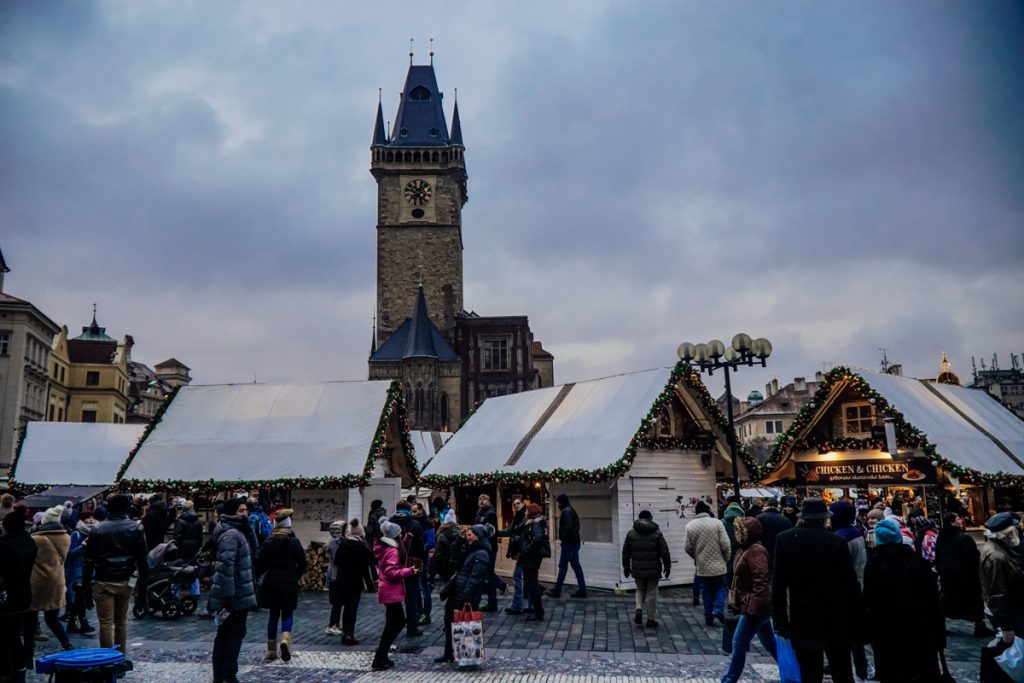
Getting to Prague is quite easy, whether you get in by train, bus, or plane!
Many people will arrive by train from another European city – usually Vienna, Bratislava, or Budapest. Luckily, the main train station (Hlavní Nádraží) is connected to the metro (line C) and is also easily within walking distance of many accommodations in Prague 2.
If arriving by bus, most people arrive at the Florenc bus stop or at Hlavní Nádraží (I took a DE bus from Nuremberg which dropped me off here). It’s easily connected by metro as well by lines B and C.
If arriving by the airport, note that there is no direct metro connection. You will have to take bus 119 to Nadrazi Veleslavin, then transfer to the Green line (A), where you can continue on to the city center.
Many people prefer to take a shared shuttle transfer or a private transfer – I recommend this company for shared transfers (cheap at about 10 euro per person and less in small groups) and this one for private transfers (about 25 euros for a group of 4 or fewer).
I don’t recommend taking a taxi from the airport in Prague. Prague is known for its scammy taxis, so go with a pre-booked transfer service or take the bus and metro.
Allison Green is a former teacher who has been travel blogging since 2016. She has a Masters in Teaching and a B.A. in English and Creative Writing. Her blog posts merge her background as an educator with her experience traveling to 70+ countries to encourage ethical, meaningful travel. She has been a speaker at the World Travel Writers Conference and her writing, photography, and podcasting work has appeared in National Geographic, CNN Arabic, CBC Canada, and Forbes, amongst others. Now a full-time traveler, she has lived in Prague, Sofia, New York City, and the San Francisco Bay Area.
